THE WORLD WAR II OSS BLACK PROPAGANDA POSTCARDS
by SGM Herbert A. Friedman (Ret.)
NOTE: this article has a Table of Contents at the end
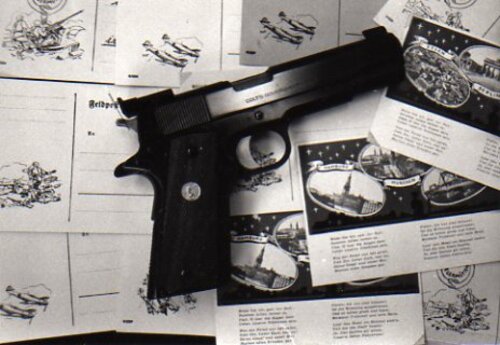
This article is reproduced on the MPHS website with the permission and assistance of its author, Herbert A. Friedman.
Ownership of the article is his alone.
The original article is located on "psywarrior.com"
The Postcards
This postcard article, in an abridged form, first appeared in the Scott Stamp Monthly, June 1985, as “Black Mail of the OSS” and more fully in the German Postal Specialist, February 1987 as “The American Propaganda Postcards of WWII.” I first wrote about the letter sheets in “Propaganda Ricocheted Round Both Sides,” The American Philatelist, November 1985. Those magazine articles were in black and white and I thought these extremely rare postcards deserve to be shown in full color. In December 2014, the National Archives requested this article to add to their WWII files prepared by the Office of Strategic Services and preserved by the CIA.Images and text from this article were published in the Journal of the Military Postal History Society. In 2016, National Geographic Magazine requested the use of several images from this article for the book “Secret War.” The Office of Strategic Services Society added this article to its section “OSS Resources.”
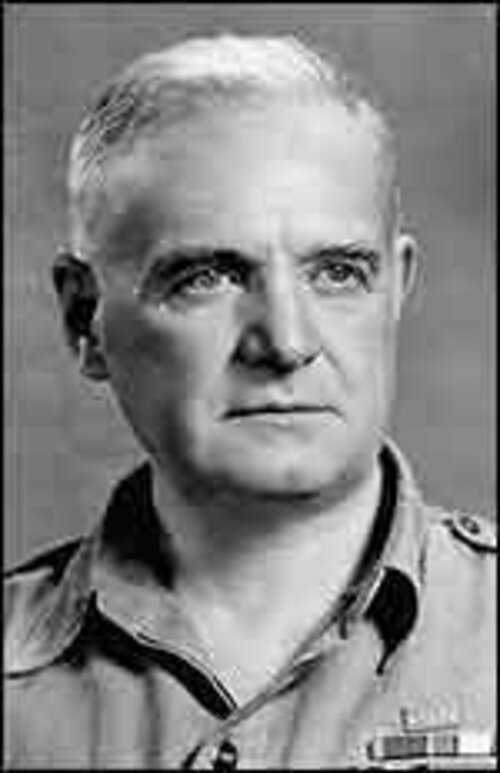
General “Wild Bill” Donovan
On 11 July 1941, approximately five months before the United States of America entered World War II, President Franklin Roosevelt appointed William Donovan to head a new agency that would become known as the Office of the Coordinator of Information (COI). This organization was to become the United States’ initial entry into the field of espionage, propaganda and sabotage. Within a year the stress of attempting to coordinate legitimate news and factual propaganda with the various “dirty tricks” of the saboteur and guerrilla caused a tumult which resulted in the COI being split into two new agencies.
On 13 June 1942, a Presidential Executive Order abolished the COI. Thereafter all legitimate “white” propaganda would be prepared by the Office of War Information (OWI) headed by Elmer Davis. White propaganda in general states its origin. It comes from openly identified sources, and makes no attempt to hide its origin. It is the most common type of propaganda.
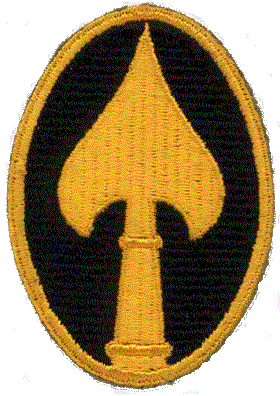
OSS Symbol
The clandestine or “black” propaganda would be the responsibility of the Office of Strategic Services (OSS) which was left in Donovan's hands. Black propaganda is false information and material that purports to be from a source on one side of a conflict, but is actually from the opposing side. It is typically used to vilify, embarrass, lie to or misrepresent the enemy.
The three major functions of the OSS organization were to be the continuation of scholastic and informal intelligence, black propaganda operations and subversive operations in collaboration with regular military authorities. The reason for two separate agencies and this duplication of propaganda activities was the belief of some Washington leaders that all news coming from the United States should be identified, factual and verifiable. It was thought that by building a reputation for honesty the enemy would learn to respect and believe our newscasts, newspapers and leaflets. The British Broadcasting Company was often cited as an example of the kind of credibility that these officials desired. They also had separate agencies for white and black propaganda.
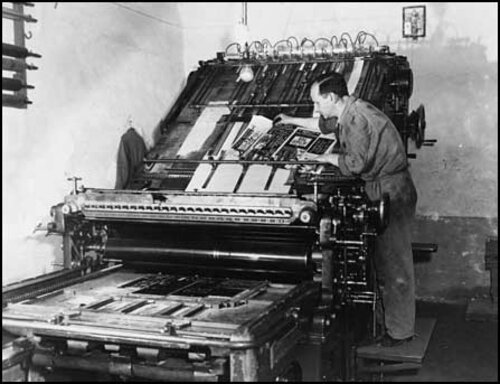
The OSS Printing Plant
At the same time, there were those who believed that no opportunity to attack, harm, embarrass or mislead the enemy should be ignored. They demanded that our propagandists lie, cheat, rumor, gossip, and fully utilize any program or concept that might lead to ultimate victory. A covert operation, with no responsibility to identify its source, would be free to play all sorts of nasty tricks that might be seen as undesirable and immoral for a legitimate government.
In the Mediterranean Theatre of Operations, OSS-MEDTO moved its headquarters from Tangiers to Algiers in November 1942. OSS-MEDTO was commanded by Arab-speaking Colonel William A. Eddy, who remained in command until July 1944, when North African Theatre of Operations military headquarters (NATOUSA) moved from Algiers to Caserta, Italy. In 1943 OSS-MEDTO was given the military designation 2677th Headquarters Company (Provisional) G-3. To increase its autonomy in May 1944 the unit was designated a regiment, officially the 2677th Regiment OSS (Provisional). The regiment was activated in July 1944 with the move to Caserta. The regimental commander was Colonel Edward Glavin, a Strategic Services Officer of MEDTO. Rome fell to the Allies on 4 June 1944, and the OSS immediately established an outpost there. Soon the 2677th OSS Regiment moved to Rome, and by 1945 Colonel John Riepe was commanding.
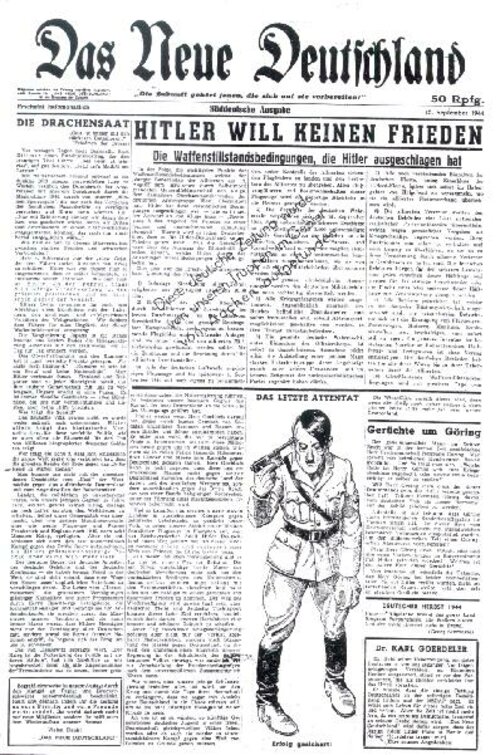
Das Neue Deutschland
Within the OSS, the Deputy Director of Operations was responsible for influencing morale and initiating sabotage, special projects and guerrilla warfare. The Morale Operations Branch (MO) was assigned the job of influencing enemy thinking by means of black propaganda. This was information that had to appear, at least at first glance, to have come from the enemy's own ranks. Some methods used were forged newspapers, military orders, postage stamps, ration books and other documents. Two successful operations using air-dropped mailbags or German prisoners-of-war who volunteered to go behind the lines and spread propaganda were called “Cornflakes” or “Sauerkraut.” Other named operations were “Sheet Iron” (the printing and dissemination of the Italian language propaganda newspaper Riscossa Italiana), and “Pig Iron” (the printing and dissemination of the German language propaganda newspaper Das Neue Deustchland).
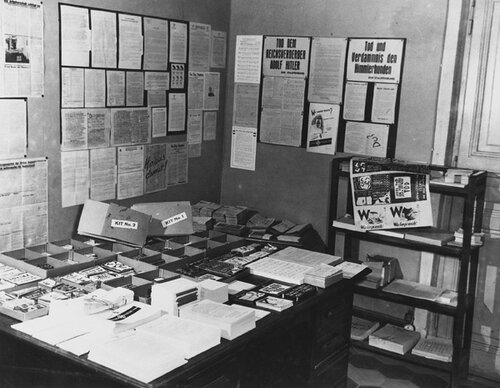
OSS Leaflets stacked for dissemination
An example of a less successful operation that used Italian prisoners-of-war behind the lines was named “Ravioli.” Readers that want to read more about the Cornflakes operation should see my article “ Poison Cornflakes for breakfast”. More information on Operation Sauerkraut can be found in my article “ Operation Sauerkraut”.
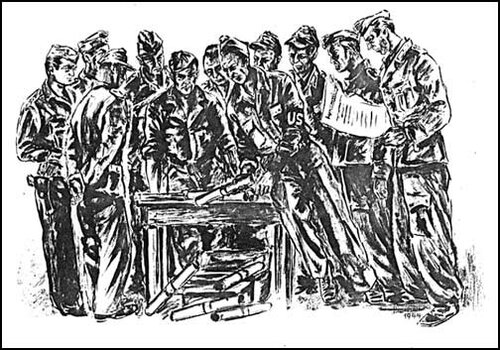
A Study of the OSS Leaflets before the Mission
I have a complete file of the entire Sauerkraut operation and every mission mentions the dissemination of MO propaganda behind enemy lines. They apparently used agents, aircraft and boats. Some examples are:
Mission 2: Disseminate specially prepared black propaganda material throughout their itinerary, placing special emphasis on bivouac areas, installations, and vehicles. Material to be left on the floors in buildings likely to be used as headquarters by retreating front line troops. If possible, materials to be posted in public places in any town entered.
Report of Morale Operation Missions – 16 to 31 October 1944: During the period a total of nearly 1,000 pounds of MO material was dropped with air supplies into Northern Italy.
Report of Morale Operation Missions – 1 to 31 November 1944: The Maritime Unit (MU) placed a large quantity of MO material received from this sector through the enemy lines by sea in the Adriatic (8th Army) sector.
Brief of Sauerkraut Missions I through IV: MO propaganda was left in a collecting station for the wounded. Leaflets were planted on the walls of the station, inside officers’ quarters, in supply trucks, storage warehouses and in six ambulances left unattended. Other MO material was left in Tiger tanks standing by for action.
In this article I will not discuss those intricate and involved psychological warfare campaigns that comprised hundreds of stamps, air letters, postcards, leaflets, gummed labels, and newspapers. We are interested only in the postal implications of the espionage material, in particular those documents that were forged to resemble genuine German postcards. The OSS produced a series of such cards with military or scenic vignettes bearing no sign of being Allied productions. All had German wording such as Feldpost or Postkarte. Some of the cards were blank on the address or message side. Others contained preprinted addresses or messages with anti-Fascist or defeatist propaganda. The theme of the “black” propaganda was always to remind the German soldier that his real enemy was the Nazi Party and the German High Command. It was hoped that when these cards got into the hands of German soldiers and civilians, the readers would be convinced that there was a strong anti-Nazi underground in existence within their own military and homeland. All of the propaganda postcards produced by the OSS were facsimiles of genuine German postcards then in circulation.
On 4 June 1944, American and British troops entered Rome. The MO unit of the OSS was close behind and it is thought to have had the capability to print propaganda documents by 15 July 1944. Documents in the OSS files point to Stabilimento Aristide Staderini, Via Baccina 45, Rome, as the printing plant utilized by their Rome MO office.
MO Rome was headed by Eugene P. Warner, a civilian, formerly of the Associated Press, and postwar public relations director of TWA. Warner’s title was MO Chief. His executive officer was Captain William T. Dewart Jr. (scion of the New York Sun publishing family).
An official OSS production report for 30 November to 31 December 1944 verifies the printing of these cards. This report states that 45,000 forged postcards were produced in the Rome printing plant during the preceding six-month period. A second document, “The Final Report of Production and Distribution from 15 July 1944 to 15 May 1945” (the war in Europe ended 7 May 1945) states that the total production of postcards reached 94,100 with 34,700 being sent to Brindisi; 41,842 to North Italy; 9,750 to France and 7,800 for special missions. The total cards actually distributed behind enemy lines by the OSS in Rome numbered 54,100. We assume the rest of the propaganda material was burnt at the end of the war.
We do not know how many postcards were prepared and distributed by other OSS stations. OSS Stockholm produced approximately 250,000 pamphlets, leaflets, stickers, posters, letters and postcards. At the same time, the OSS in Bern printed and smuggled millions of pamphlets, leaflets, postcards, postage stamps and other literary propaganda into Germany and Fascist Italy. There were also stations in Algeria and Istanbul.
The MO Rome postcards are extremely rare, and the only ones known to exist, with two exceptions, are the specimens that were stored in scrapbooks prepared by the OSS. In the half century since the end of the war we only know of two such official scrapbooks that have been offered for sale at auction. Both contained specimens of these cards. It is possible that there were other private sales of additional scrapbooks. It is safe to say that there are no rarer propaganda postcards from WWII. Many exist as only one specimen. We must assume that the thousands of other propaganda postcards produced by OSS printers and distributed behind the lines were discovered by the enemy, gathered up, and destroyed. The paper propaganda left on the ground to be found by passing German troops would eventually dissolve from rain and snow or might have been used by troops to start campfires or even toilet paper as once stated by British Air Lord Sir Arthur “Bomber” Harris. Any German soldier found harboring such a card would have certainly been in serious trouble.
Where did the cards come from?
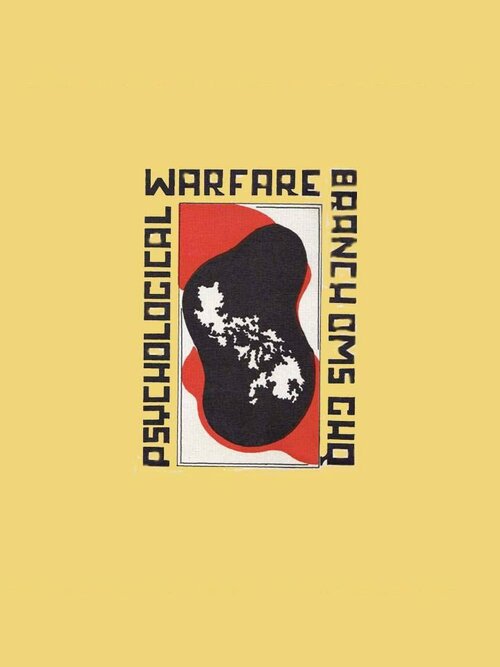
Psychological Warfare Branch (PWB) Scrapbook
We need to take a moment to explain the origin of these cards and the concept of the propaganda scrapbooks in general. During WWII such scrapbooks were prepared by members of the OSS in Bern and Rome, and by the members of the Psychological Warfare Branch (PWB) and the Office of War Information (OWI) in the Pacific. In some cases these scrapbooks were prepared as a history of the unit’s production, in other cases as gifts for visiting politicians, and sometimes as souvenirs for the unit members. The most common seem to be the PWB scrapbooks consisting of leaflets to Japanese soldiers on Okinawa, Formosa and the Philippine Islands. These books are entitled: Psychological Warfare Branch Leaflet Book. Many unit members were presented with these books upon discharge from the military. I believe there could be as many as 20-30 of these scrapbooks. I personally know of about eight of them.
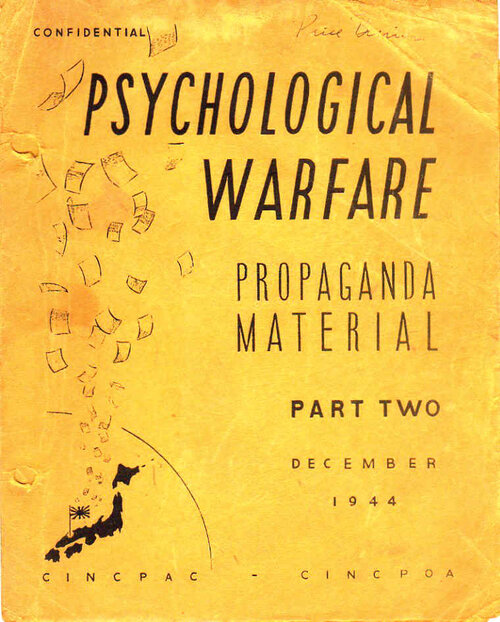
I know of about a half-dozen of the OWI scrapbooks entitled: United States Pacific Fleet and Pacific Area Psychological Warfare; mostly prepared by officers and administrators assigned to the Saipan OWI unit. I own one, I have seen one offered at auction and I have seen one in the reference section of the New York Public Library.
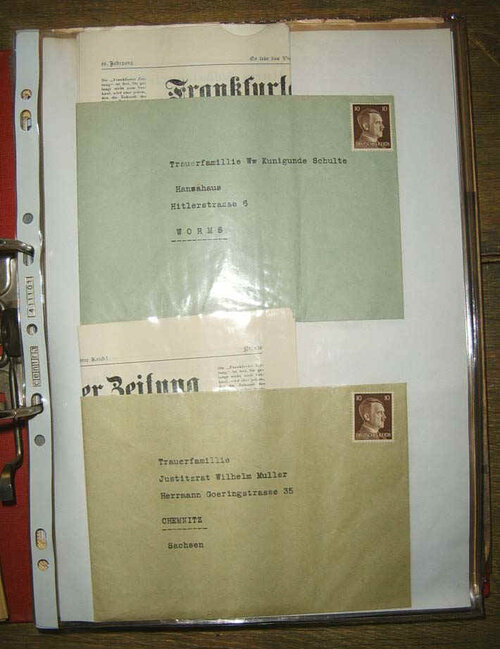
The Bern Scrapbook
The OSS Bern scrapbooks are very rare. It is thought that Georges Meyer, former Director of Services for the French War Ministry of Press and Information was given a scrapbook by the French forger Schuhl (codename “Salembier”) who worked for the OSS. At one time this collection was deposited in the Service Historique de l'Armée at Castle Vincennes. Another was purchased in a collection of old paper sold for scrap and one is in the archives of a West Coast University.
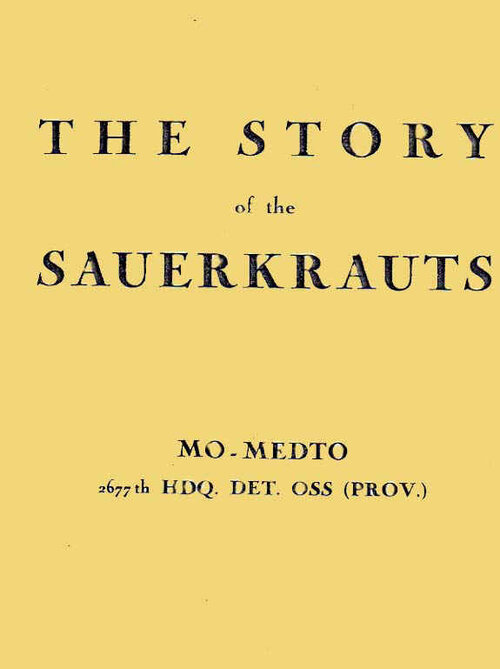
The Rome OSS “Sauerkrauts” Story Book
I am only going to mention this book in passing since none of the actual propaganda products were placed inside. It tells the story of the Sauerkraut missions, and illustrates that story with dozens of official photographs and many charcoal sketches by a German prisoner-artist. The photos are of interest because they prove that the postcards were carried into Germany by collaborating prisoners of war. The sketches are of interest because they illustrate some of the actions of the Sauerkraut teams both during training and in action behind the German lines. The drawing earlier in this article: “A Study of the OSS Leaflets before the Mission” is one of the sketches prepared by German prisoner Willy Haseneier, an artist and graduate of the Dusseldorf Art Academy used by his OSS handlers to forge identity papers, passes, credentials and signatures. At the end of the war he worked for the Allies producing visual aids for the Nurnberg trials. He immigrated to Hollywood after the war and found fame as “Will Williams,” illustrating book covers, comic books, movie posters, and portraits of actors. Ironically, some of his drawings were called "the secret agent series," a subject he was very familiar with.
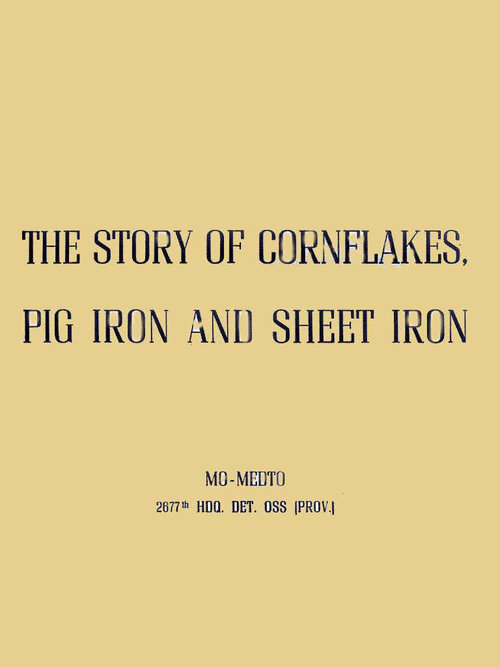
The Rome OSS “Cornflakes” Story book
There are three different kinds of OSS Rome MO books. One is a thin paper-back publicity booklet that explains the operations and contains photographs and souvenirs. I call this “the story book,” but the complete title is: The Story of Cornflakes, Pig Iron and Sheet Iron. It is alleged that shortly after the war some were sold. One buyer told me that he had paid $250 for the story book and said he was told that 20 to 30 were printed for members of the Congressional Watchdog Committee.
A second book contains maps and comments on the German forces and their movements. This is “the Order of Battle book.” Most front-line military units keep such a book so they always know the strength and make-up of enemy forces opposing them.
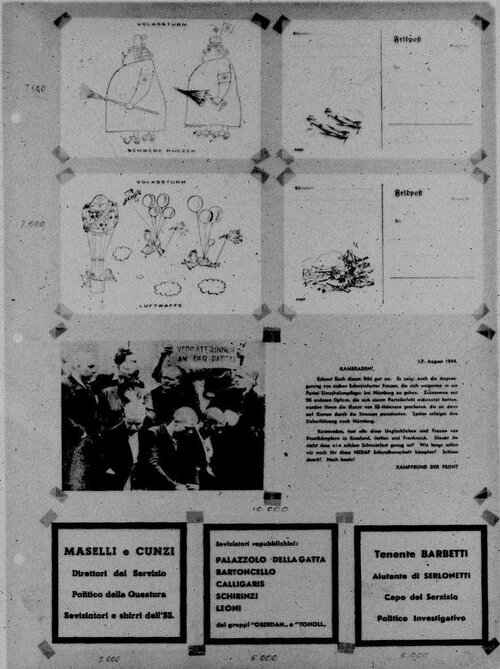
A Rome OSS Scrapbook Page with Mounted Postcards
Notice the notation that 7,500 of each card were printed.
The last and most important is a large hard-cover scrapbook that usually contains several hundred mixed MO printed specimens and photographs. The books were prepared by the Morale Operations section of the 2677th Headquarters Detachment of the Office of Strategic Services, (Provisional) Mediterranean Theater of Operations, located in Rome.
Kermit Roosevelt mentioned the unit in: The Overseas Targets – War report of the OSS, Walker and Company, New York, 1976. He said:
The regiment was not activated until July 1944. At that time, AFHQ moved from Algiers to Caserta. Headquarters of the 2677th Regiment OSS (Provisional) was established at the former Fifth Army Detachment base in the palace at San Leucio, near Caserta, with complete responsibility for all OSS operations from the Mediterranean into France, Italy, the Balkans and the Middle East.
After the war, four books were found in the attic of the building where OSS members were housed since the occupation of Rome. They were found by the new tenant who was cleaning the attic and discovered several bound volumes stored there.
In 1971, a “story book” and a “scrapbook” was exhibited at the International Exhibition held in Cape Town, South Africa by the auction House of Robson Lowe. The books were later offered at auction on 23 October 1979, by Robson Lowe, Ltd. in Basle, Switzerland. They contained 205 items for Germany including 4 propaganda postcards, 31 forged envelopes, 4 music sheets, 140 notices to the German civilians and armed forces (leaflets, letters, and gummed stickers), 12 copies of Das Neue Deutschland, 48 items for Austria, 8 items for Czechoslovakia, 1 item for Hungary, and 46 items for Italy. In addition, 24 photographs were in the book
Lowe described the lot:
Comprising a book printed in Rome May 1945…A remarkable historical collection concerning psychological warfare based on the dissemination of information through the mails and other channels, offered on behalf of the officer in charge of these operations, whose assassination was ordered by Himmler. The owner is still in good health.
Lowe estimated the value of the volumes at 10,000 Swiss francs (about $6,000 U.S. at the time). I spoke to Robson Lowe that year and he told me:
One of the books includes photographs of the various stages of the operations. I have added nothing to the collection but removed from the bound volume certain exhibits which had been mounted on album pages for display. The second volume contains all the exhibits concerned with this operation and some of the other operations in Italy and elsewhere.
The tenant of the apartment from whom I obtained these two volumes apparently found them in the attic but the apartment had been used by American officials since the occupation of Rome and it would appear that one of the predecessors left these two volumes along with a third volume in the attic. My guess is that the owner was one of the main officials in the report.
I have made reference to a third volume but it is a German Order of Battle printed in English and kept up to date with pencil notes of the movements on the Italian Front. It seems obvious to me that the owner of this book would have been an intelligence officer and as all the volumes were found together in one parcel I believe they all belonged to one owner.
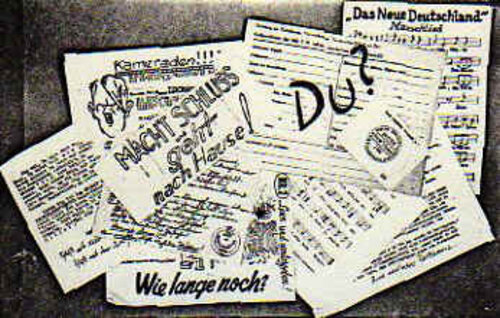
Photograph from the OSS Booklet “The Story of the Sauerkrauts”
The small and blurry black and white photograph is one of several dozen mounted in a story book produced by MO Rome for the Sauerkraut mission. If you look carefully, you can see the propaganda postcard 1B (see below) partially covered in the center of the photo. Note the “Ring der Kriegemutter” at the lower right. Another photograph depicts the Sign of Life propaganda card depicted below. Some of the texts that accompany the various photographs depicting propaganda products are:
No mission was complete without propaganda material
German Army vehicles moving toward the north were loaded with substantial supplies of material such as this.
German soldiers, sleeping along a roadside awakened to find leaflets covering their faces that told them to go home.
Others found newspapers emanating from homeland underground movements in their latrines.
The United States National Archives has microfilm tapes of 11 sample books of propaganda materials produced by the Morale Operations (MO) Branch of the OSS during the years 1943–1945. These scrapbooks contain samples of propaganda leaflets, stickers, newspapers, sheet music, stamps, post cards, poems, cartoons, and booklets. Propaganda was distributed in Italy, Greece, the Balkans, Germany, Central Europe, the Japanese Pacific, China, and French Indo-China. The scrapbooks form the series Propaganda Sample Books, 1943–1945.
Most of the books are connected to China and Japan. The ones that are connected to MO Rome are books 5 and 6 (perhaps a story book and a scrapbook) that consist of “black” propaganda produced in Rome, directed toward enemy groups in Italy consisting of German, Italian, Russian, Polish, Mongol, Czech, and Austrian troops and fascist civilians in Italy; German and Austrian troops as well as German puppet troops and pro-Nazi civilians in the Balkans; and German and puppet troops as well as pro-Nazi civilians in Central Europe. Also targeted were pro-Allied groups in enemy-occupied territory consisting of Italian, Slovakian, Yugoslavian, and Greek partisans, and anti-Nazi civilians in Italy, Germany, Central Europe, Greece, and the Balkans. The materials include newspapers, news sheets, and leaflets in several languages with instructions for distribution; letters; political cartoons; posters; popular music; postcards; photojournalism; surrender leaflets; slogans; and language guides.
U.S. Army First Lieutenant Robert Allen also saved specimens of the OSS Rome MO propaganda in several scrapbooks to preserve documentation for congressional leaders who would determine support for MO activities. Early unverified reports implied that at least four of Allen’s scrapbooks survived the war. In addition, Army Corporal Egidio Clementi, the chief MO printer, collected two copies of all printed MO Rome propaganda. In the 1960s he donated one set to Guilio Polotti, the president of the Anna Kuliscioff Foundation in Milan, Italy.
One “Allen scrapbook” was sold in 1984 by Harmer's Prestige Auctions, New York City. The seller of the book claimed that Robert Allen had prepared six such large scrapbooks, with heavy covers, about 1 inch thick, and fastened with three brass screw-and-socket connectors. The pages were 15 x 22-inches. This book contained 64 pages, with about 290 major documents and 190 small stickers, with minor duplication, making a total of about 480 pieces. Among the more interesting items were 14 of the OSS propaganda postcards; 6 feldpost letter sheets; 1 feldpost wrapper; 1 “Sign of Life” postcard; 1 complete sheet of the Futsches Reich skull stamp parody; 2 sex leaflets; and 1 sex booklet. There were several copies of Das Neue Deutschland (small size), and many other documents. Fourteen different propaganda postcards were found in the scrapbook. There were also eight duplicate cards mounted to show the reverse side. This scrapbook was estimated at $5,000 but did not sell at that price or reach the reserve of $4,000. Later, it was privately purchased by an American collector for $3,700.
This lot was described as:
The original, complete sample book (thought to be the only one in existence), displaying extensive anti-Hitler and anti-Fascist literature, newspapers, propaganda leaflets, etc., as printed and compiled by one of the original directors of the entire operation, Robert Allen. Well over 300 items, the documents are mostly in German but also some in Italian and Russian. Included is a large production report, photographs of the presses and a complete stuck down sheet of 50 of the Hitler Death Mask propaganda label (Michel #17) as manufactured by the Rome printing presses. Estimated cash value $5000.
This book, although a great rarity, is not the only one in existence, as we know from the earlier Lowe auction. However, as an historical reference to the secret work of the OSS in Rome, it is invaluable.
In Australian Stamp News, Volume 26, No. 2, it is alleged that a copy of the scrapbook was placed in the United States Library of Congress for reference purposes. I spoke to the Christie’s – Robson Lowe auction house in 1985 and was told by Lowe in regard to the OSS books:
The officer in charge of the Office of Strategic Services came to see me and brought some duplicate material. He told me that four of these books had been made, one of which was in the Congress Library.
When queried, the Congressional reference librarian stated that although they have 17 titles related to the OSS in Italy, they did not have an example of the MO scrapbook. I doubt that we will ever know exactly how many were prepared since aside the official scrapbooks, some of the MO personnel certainly prepared scrapbooks for their own use. Americans are great souvenir collectors.
Each of the scrapbooks was slightly different. They were prepared as needed and filled with the various propaganda stamps, postcards, letter sheets, leaflets, newspapers and stickers that were on hand in the MO printing shop at the time.
There are several sources for this MO propaganda. Clearly the scrapbooks found in Rome are the major source. I have been told that besides Lieutenant Allen, a second OSS operative also sold a number of these propaganda products to Werner Bohne in the 1980s. Werner M. Bohne, the now-deceased German Philatelic Society forgery expert told me about one of the story books he purchased directly from former First Lieutenant Robert Allen of Portland, Oregon, whose official United States Army separation qualification record reads:
Intelligence Officer. He was assigned to the Office of Strategic Services and went to Italy where he was Executive Officer of the OSS branch collecting and evaluating intelligence on foreign policies. He also supervised the operation of the print shop. In June 1945 he became Executive Officer of a Field Photographic Branch of OSS supervising the taking of still and motion pictures and supervising and working on aerial photography.
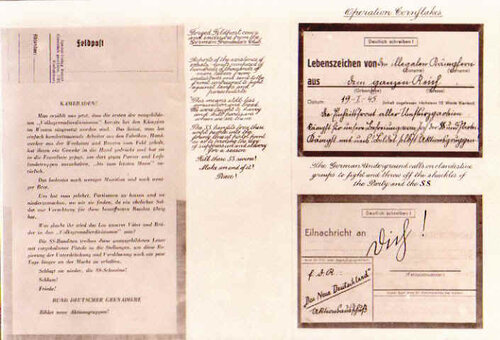
A Page from the Bohne Story Book
Note the fake letter sheet at the left and the fake “Sign of Life” card at the right.
Bohne wrote about the Cornflakes operation in an article entitled “Cornflakes Number now Known,” in the German Postal Specialist, November 1995. He did not mention the postcards because there were apparently none in the book he purchased. I often visited Werner in those days at his house in Longwood, Florida. In regard to his story book he told me in 1984:
A large part of my material came from two former OSS people who worked under Donovan, both are now probably deceased. I believe that the books, as far as the texts are concerned, are all alike. The blank pages in the back were filled by the individual officer. In the case of the book that I have, there are lots of photographs showing leaflets being placed into bombs, actual bomb runs, etc.
One of these OSS propaganda postcards was found behind enemy lines. The story appears in the spring 1984 issue of the Falling Leaf, the journal of the psywar society, an international association of Psychological Warfare historians and collectors of aerial leaflets. Member Joshua C. Bray sent in a large number of black leaflets in the German, Italian and Polish language. Among them was a postcard with propaganda text on the back (see Card 1B below) and a “Sign of Life” card. They were saved from destruction when souvenir collectors among the American combat troops discovered a cache of propaganda material on and around dead Wehrmacht soldiers in Italy sometime after the Anzio breakout. A group of American soldiers had been ordered to search a mountain overlooking the Allied lines. Former Army Corporal Kenneth Brinkman told me:
We found a number of dead Germans that appeared to be sitting with their backs against a low stone wall. They looked like they were sleeping. We found that they had been shelled and apparently the concussion from a low air blast directly overhead had killed them all. There were no wounds on the bodies. We looked through their knapsacks and found the propaganda material. A little later we found another knapsack filled with bundles of leaflets, stickers, and even toilet paper with anti-Nazi cartoons.
Who was this dead German? Why did he have this Allied material? Had he captured it during some raid on Allied forces? Was he carrying it behind German lines to disseminate it? In Corey Ford's Donovan of the OSS, published by Little Brown and Company, Boston, 1970, we find the following remarks:
Distribution of the black propaganda items was often accomplished by carefully screening prisoners of war who were sent back, still in German uniforms, to the enemy lines.
Other evidence of this operation is found in Anthony Cave Brown’s The Secret War of the OSS, Berkley Publishing Corporation, 1976. Brown states:
The OSS operations utilized carefully picked POW's who were infiltrated in German uniform behind enemy lines.... None of the POW's used in these operations were captured by the Germans nor, so far as is known, were any of them 'turned' against MO. In addition to their distribution of subversive material, the agents brought back valuable tactical intelligence.
Was the dead Wehrmacht soldier an Allied agent who was killed by shells from the wrong side? The true stories of war are sometimes stranger than fiction. The historic value of this postcard is that it shows that attempts were made by the OSS to place this propaganda into the hands of the enemy during the battle for Italy. There are probably other such cards in private collections, but this is the only one that we can guarantee saw use in a psychological warfare operation.
A second propaganda postcard was found in a box in a storage unit in Chicago. The box was full of military documents such as personal letters from U.S. Army General Mark Clark and other material dealing with the trial of German war criminals and related wartime communications. This is the only known example of the Dornier Do-215 propaganda postcard depicted below.
Now that we know where they came from, let’s return to the actual propaganda postcards.
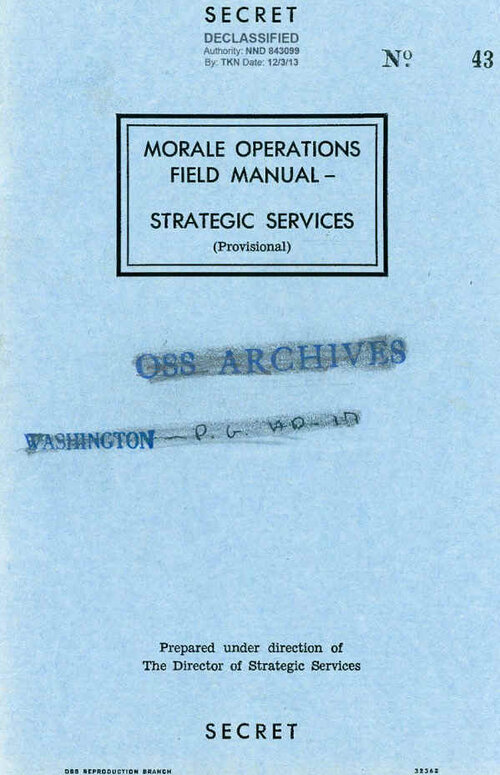
Morale Operations Field Manual - Special Services
What was the purpose of all these postcards, leaflets and letters that appeared to come from inside Germany? In 1943, the OSS published a classified secret Morale Operations Field Manual - Special Services. It explained the philosophy, concepts, operations and definitions needed by agents in the field.
Forgeries includes the writing of poison-pen letters, forging of misleading intelligence documents, falsification of enemy documents and periodicals, and the printing of false orders to the enemy, regulations, and proclamations. Leaflets, pamphlets, and graphics are used for subversive deception within enemy and enemy-occupied countries and not identifiable with any official or semi-official United Nations agency.
FALSE LEAFLETS, PAMPHLETS, & GRAPHICS: This type of implement refers to printed, mimeographed or written literature and graphics distributed secretly in enemy territory and under concealed sponsorship. This includes chain and, other anonymous letters, chalking symbols and messages on walls. The false pamphlet sponsored by a belligerent nation attempts to convey the impression that it is a bona fide message from the people's own fellow country-men who are sharing the same risks as the rest of the population and have similar aspirations, aims, and goals.
An appeal to nationalistic attitudes is more effective when made by the nationals of the group than when made by another nation which has its own nationalistic axe to grind. Likewise, incitement to action or revolt coming from a representative of an aggrieved group is more effective than such incitement coming from an "outsider." Whenever an attempt is made to assure potential sympathizers that they would not be alone in resistance activities, such assurance comes better from a group which is presumably carrying on the same activities under the same conditions and taking the same risks.
USES OF LEAFLETS: In general, the leaflet can be used for dissemination of "forbidden" news, spreading of rumors, exposing nefarious activities of enemy officials and collaborationists, giving reassurances to potential sympathizers, instructing in sabotage, inciting to subversive activities, and preparing the populace for cooperation with invading troops. The false leaflet can be capitalized upon by propaganda agencies in popularizing a passive resistance campaign (such as the "V" campaign or the "1918" campaign). It may be desirable to have the campaign "planted" via false pamphlets. This "spontaneous" activity can then be picked up by the authorized propaganda agencies. (2) The false pamphlet can be effectively used to make the enemy uneasy about the loyalty of the people in the territory. The very existence of clandestine pamphlets is "evidence" of underground activity.
THE OSS FORGED POSTCARDS
All of the known cards measure about 148 x 105mm. They have been found on bright white, dull white, cream and gray paper. It is difficult to tell if the different shades of white were intentional or were caused by over 50 years of aging. All these OSS propaganda postcards were produced by the MO unit in Rome.
Genuine German Postcards from the Military Series
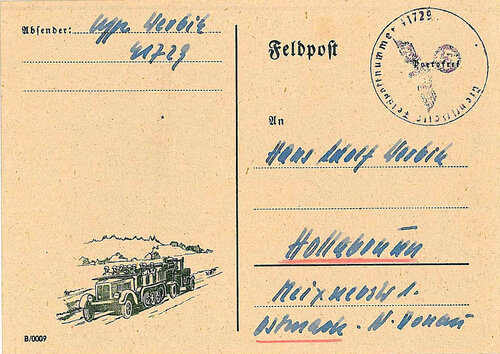
The Tracked Personnel Carrier – Not copied by the OSS
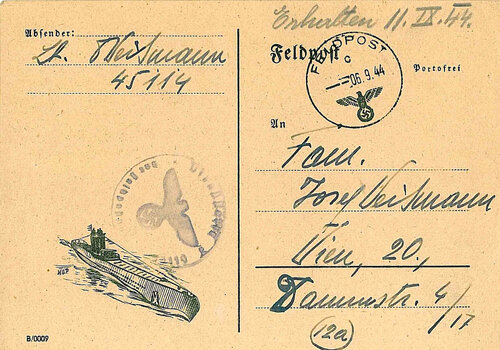
The Submarine card – Not copied by the OSS
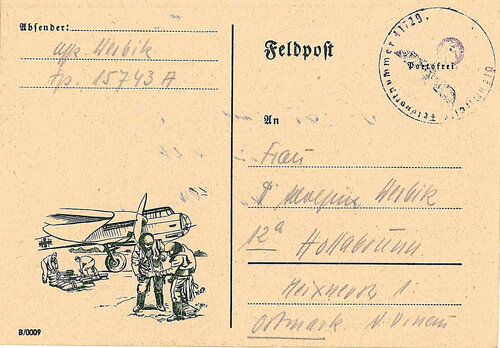
The Dornier Do-215 card – Copied by the OSS
In arbitrarily placing these OSS parodies into categories according to their vignettes, the first set of cards is the “military cards,” based on genuine German postcards. We have organized these OSS parodies into categories according to their vignettes. Under this heading we find drawings of fighter planes, dive bombers, medium bombers, infantry, mortars and anti-aircraft. The other genuine German postcards from this set that were not parodied have vignettes such as tanks, a tracked personnel carrier, a submarine, and a battle-cruiser. The OSS may have copied these vignettes too, but none have been found to date. Within this military category we find OSS postcards that are addressed, unaddressed, with and without preprinted messages, and with humorous caricatures in place of messages.
The cards with military themes, unless otherwise specified, are found on white paper. All have the code "B/0009" in the lower left corner. The artist's initials, “HOP” is beneath. A military drawing appears at lower left; the artist's initials “HOP” are contained within the drawing. The cards have three lines at the upper left for a return address (Absender), four lines at the right for the address (An), and the word Feldpost at the upper center. At the far right the word Portofrei (Postage free) has been printed. All text is in German.
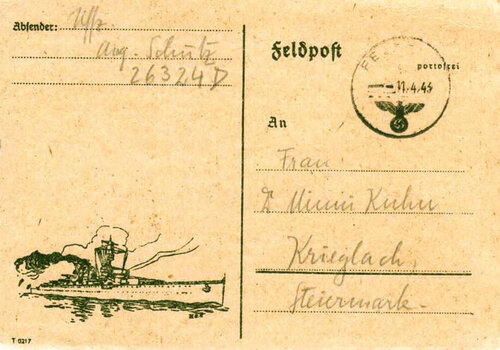
A “T 0217” Battle Cruiser card – Not copied by the OSS
Many years after I first wrote this article it was discovered that the cards also existed with the code T 0217. How odd that over 70 years after the end of WWII more postcards using some of the same vignettes appear. One of the newly discovered cards has an illustration we have not seen before; a battle cruiser. Two other T 0217 cards show the three anti-aircraft gunners and the three Stukas depicted on the B/0009 cards. We can now say that the “HOP” illustrations were printed in two series with the code numbers B/0009 and T 0217 and apparently the OSS only copied the B/0009 series.
A second group shows photographs of various German cities and we have labeled them the “City Cards.”
The OSS hoped this "black propaganda" would appear as something produced by a German underground movement. The propaganda alludes to be of German origin; from organizations that were in opposition to Nazi policy. Some were blatant, some subtle; all were meant to weaken the enemy's morale and his will to resist.
THE MILITARY CARDS
Messerschmitt Bf 109 fighter planes
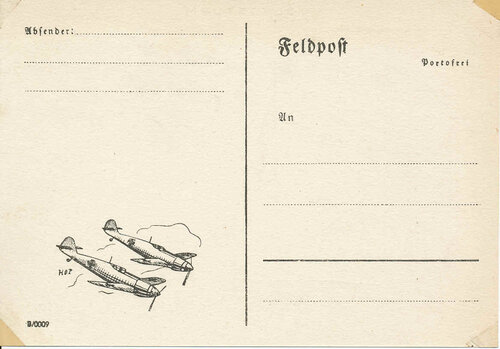
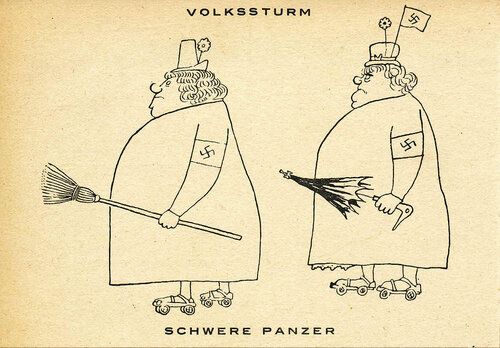
Card 1A
This card depicts two Messerschmitt Bf 109 fighter planes at the lower left on the front. There is no text on the address side. Four Messerschmitt propaganda postcards are currently known.
On the message side is a cartoon depicting two fat women wearing swastika armbands and roller skates. One holds a broom, the other an umbrella, probably to fight off Allied armor. The text at the top reads Volkssturm (People's Resistance) and at the bottom Schwere Panzer (Heavy Tanks). The card ridicules the Nazi plan to call up elderly civilians in a last ditch attempt to protect Germany from invasion. Curiously, the British had been doing the very same thing, protecting the cliffs of Dover with overage civilians armed with shotguns. The British called their forces “National Defense Companies” and required all ex-service men between the ages of 45 and 51 to enlist for four years. There was even a British television show about these older soldiers, entitled “Dad’s Army.”
David Lerner mentioned the Volkssturm in Sykewar: Psychological Warfare against Germany, D-day to VE-Day, George Stewart, New York, 1949:
The German decision to raise a Volkssturm was a golden opportunity for Sykewar’s output personnel. The prospect of an army of aged, infirm and crippled being rushed to the defense of the Fatherland on crutches and stretchers raised limitless possibilities for jokes about “scraping the bottom of the barrel,” for indignant attacks on the Nazi leadership responsible for such inhumanity to its own people, for stern admonitions to surrender quickly lest the whole German people are made to perish.
I should mention here that in 2019 German specialist Wolfgang Baldus told me he had run across a fake OSS postcard Schwere Panzer that has a genuine 1A image on the obverse and a 1D card image on the reverse. The paper looks very old, and it does not seem to be a modern forgery.
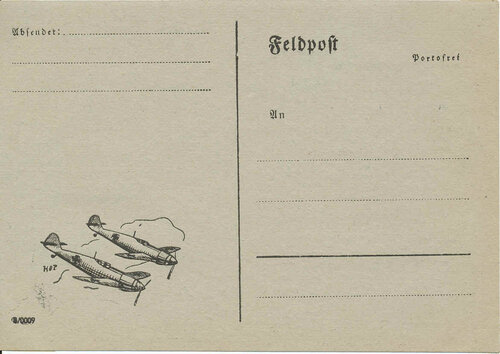
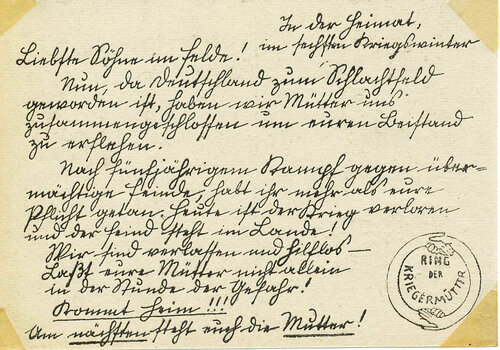
Card 1B
This card depicts two Messerschmitt Bf 109 fighter planes at the lower left on the front. There is no text on the address side.
The message side has a seal at the lower right. The seal is a circle formed by two arms with joined hands top and bottom. The text inside the ring reads Ring der Kriegemutter(War Mothers' Group).
This was an attempt by the OSS to show that within the Third Reich there was a group of miserable, lonely mothers who desired that their children leave the front lines and return home. The card has a simulated handwritten message which reads:
At home in the sixth winter of the War
Dear Sons in the Field! Now that Germany has become a battlefield, we mothers have gathered together in order to beg your assistance. After five years of struggle against overwhelming enemy power, you have done more than your duty. Today the war is lost and the enemy is in our country. We are abandoned and helpless. Do not leave your mothers alone in this hour of danger. Come home. Your mothers are your nearest and dearest!
This card has been seen only on gray paper. No specimens have been found on white paper although some poor photocopies from Europe could be interpreted either way. This postcard was found on the dead German soldier in Italy.
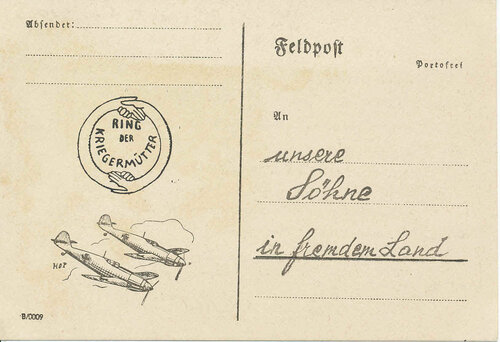
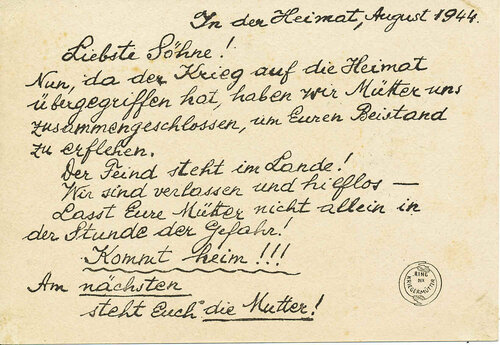
Card 1C
This card depicts two Messerschmitt Bf 109 fighter planes at the lower left on the front.
The Ring der Kriegemutter is on the address side above the fighter planes. The seal also appears reduced 50%, on the message side in the lower right hand corner. This card bears a handwritten address:
Our sons in foreign lands
On the message side is a simulated handwritten message:
From the Home Front, August 1944.
Dear Sons! Now that the war has reached the home front we mothers have united to beg you to assist us. The enemy is in our country! We are abandoned and helpless. Do not leave your mothers alone in the hour of danger. Come home!!! Your mother is nearest and dearest to you!
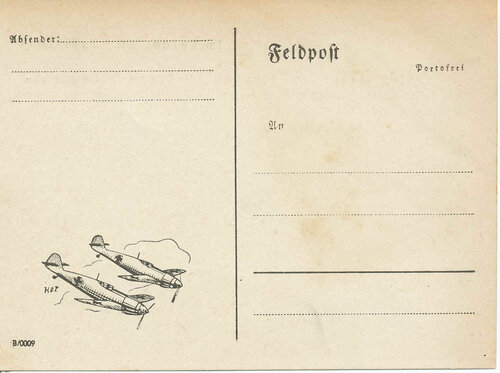
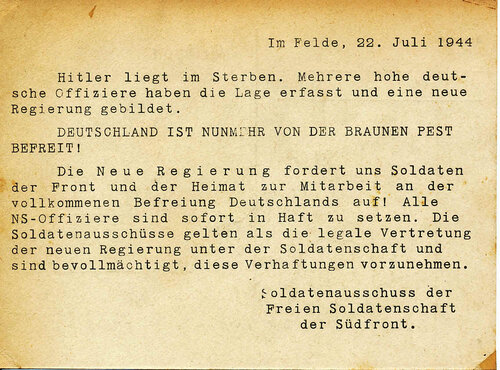
Card 1D
This card depicts two Messerschmitt Bf 109 fighter planes at the lower left on the front. There is no text on the address side.
The message side bears the printed text:
In the field, 22 July 1944.
Hitler is on his deathbed. Several high ranking German officers have taken hold of the situation and created a new government. GERMANY HAS NOW BEEN LIBERATED FROM THE BROWN PESTILENCE! The new government asks soldiers at the front and people at home to cooperate until Germany is totally liberated. All National Socialist Officers are to be jailed immediately. Soldiers' Committees are the legal representative of the new government and have full authority to effect these arrests.
This card is dated just two days after the attempt on Hitler's life. It is possible that the OSS believed Hitler had been killed or severely wounded. Members of the military were already being arrested and executed for their part in the assassination plot and this card would certainly tend to throw fuel on the fire. We should also point out that it was the impetus from the attempted assassination of Hitler that motivated the OSS to put Operation Sauerkraut (German volunteer prisoners-of-war sent behind enemy lines) into action.
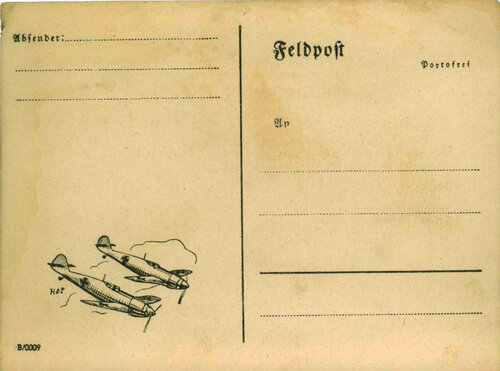
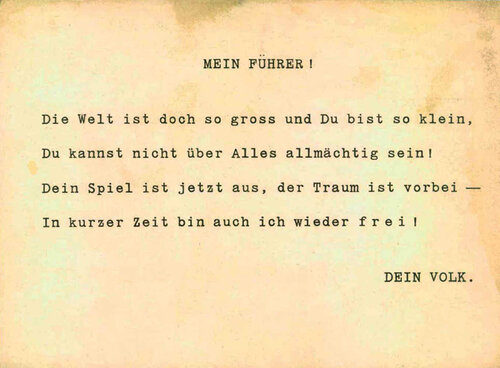
Card 1E
This card did not come to light until December 2016. Somehow, it did not make the original OSS sample book. On the front it depicts the usual two Messerschmitt’s without any additional text, and on the back a short message identical to card 6A:
My leader!
The world is so big and you're so small,
You cannot be omnipotent over everything!
Your game is now finished, the dream is over --
In a very short time I'll be free again!
Your people.
Stuka (Junkers Ju-87) dive bombers
The second series of military vignette cards are almost identical to the first except that instead of two fighter aircraft there are three Stuka (Junkers Ju-87) dive bombers at the lower left. Three Stuka propaganda postcards are known.
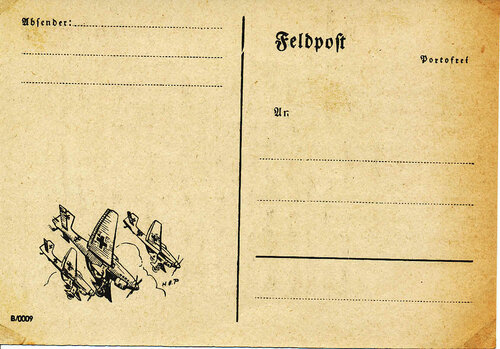
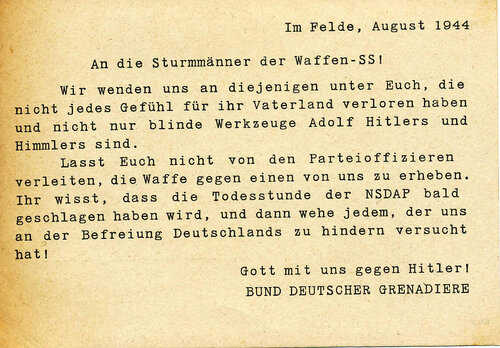
Card 2A
Three Stuka (Junkers Ju-87) dive bombers at the lower left. No text or additional symbols on the address side.
On the message side is a typewritten message reading:
In the field, August 1944.
To the storm troopers of the Fighting SS!
We address ourselves to those among you who have not yet lost every feeling for their Fatherland and have not become blind tools of Adolf Hitler and Himmler.
Do not let the Party officers mislead you and induce you to take up arms against us. You know that the death knell of the National Socialist Party will soon sound. And then, woe to those who have tried to prevent us from liberating Germany.
God be with us against Hitler!
Federation of German Grenadiers.
It is interesting to note that although we have translated the word Sturmmanner as “storm trooper,” in reality this is an SS rank equivalent to an American private first class. The message is addressed to a low-ranking soldier in an obvious attempt to speak to the German foot soldier rather than to those of the officer class.
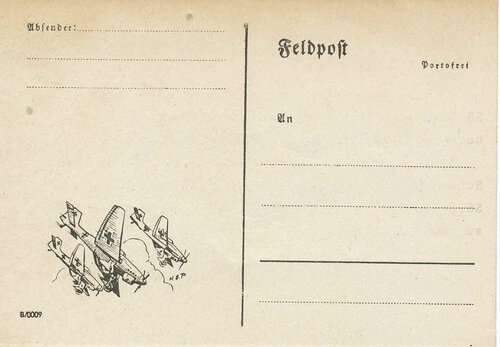
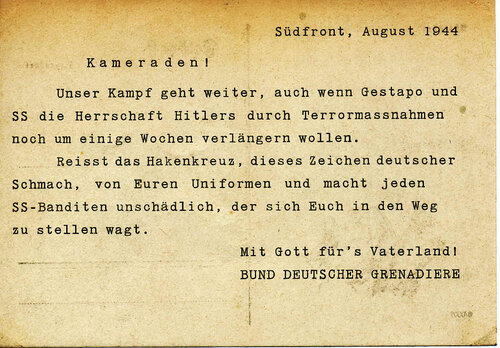
Card 2B
Three Stuka (Junkers Ju-87) dive bombers at the lower left. No text or additional symbols on the address side.
On the message side is a typewritten message reading:
Southern Front, August 1944.
Comrades! Our struggle continues even though the Gestapo and the SS wish to prolong the reign of Hitler a few more weeks by terrorist means. Tear the swastika from your uniform, this sign of German humiliation. Disarm every SS bandit who dares to stand in your way. With God for Fatherland!
Federation of German Grenadiers.
We find the term Grenadier in much of the OSS propaganda. They were trying to reach the older called-up German soldiers. Grenadier is an old traditional military term used by Germany as early as 1813 when the nation was mobilized during the siege of Kolberg. When German Propaganda Minister Goebbels announced total mobilization after the defeat at Stalingrad in February, 1943 he created the first Volks-Grenadier Divisions. These were nothing but infantry divisions, but the Propaganda Minister announced that they would be an elite force and the old name would be a special honor. Notice also that in Card 2A the OSS speaks to the SS in a friendly manner, but in Card 2B it calls the SS “bandits.”
The OSS often attacked the German concept of the Grenadier. For instance, it prepared a leaflet that was sent behind the lines to destroy civilian morale. The leaflet said in part:
They tell us now that the newly formed People’s Grenadier divisions are already thrown into the fight on the Western front. That means that they simply took one hundred thousand workers from their factories, artisans from their workshops and farmers from their fields, put a rifle in their hands and chased them to the firing lines to face tanks and airborne troops. Naturally, they are expected to fight to the last man. This means still less ammunition and still less bread…
The SS bandits chase these untrained people into their positions at gunpoint in order to maintain this government of suppression and enslavement in power for a few days longer.
Kill the SS pigs! Make an end to it! Peace!
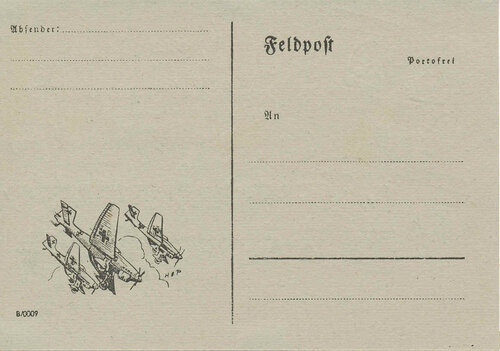
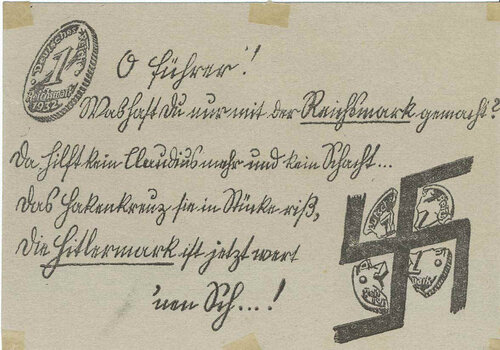
Card 2C
Three Stuka (Junkers Ju-87) dive bombers at the lower left. No text or additional symbols on the address side.
The message side depicts a 1932 One Reichsmark-coin whole at the upper left and shattered by a swastika at the lower right. The message appears to be written in the old German-style Sutterlin handwriting in a poetic form and states:
O Fuehrer!
What have you done with the Reichsmark?
No Claudius and no Schacht can help you.
It has been torn in pieces by the swastika.
The Hitler mark is now worth sh..!
The Schacht mentioned is Hjalmar Schacht, President of the Reichsbank and Nazi Economic Minister prior to WWII. As for the true meaning of the last, unfinished, word, it is not completely spelled out but because it must rhyme with the previous line. Therefore, we know that it should be “Scheiss” (shit).
I also find it amusing that when the Nazis rose to power they constantly used the inflation and depression of the 1920s and 1930 and loss of the spending power of the German mark to show how they could do things better. It was all the fault of the Jews, Great Britain and France. Now the Americans use the same type of propaganda against them. Turnabout is apparently fair play.
Infantrymen
Another series of military vignettes show three German infantrymen. One holds a rifle, one is firing what appears to be a Maschinengewehr 42 machine gun and the third is about to throw a Model 24 Stielhandgranate “potato-masher” hand grenade. Three propaganda postcards exist in this infantrymen set.
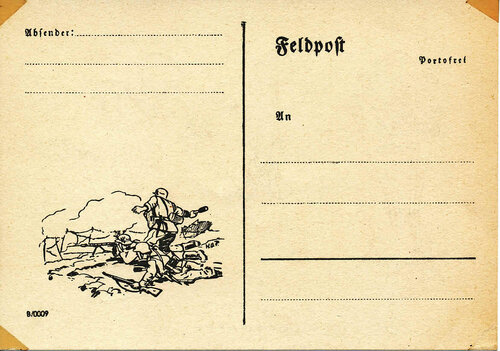
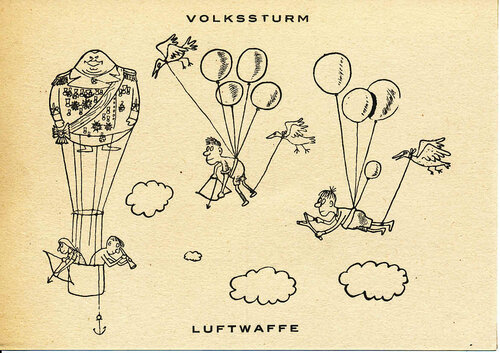
Card 3A
Three German infantrymen at the lower left. No text or additional symbols on the address side.
On the message side is a cartoon attacking the calling up of children and the elderly into the German armed forces. At the top is Volkssturm (People's Resistance) and at the bottom Luftwaffe (Air Force). At the left are two children in the basket of a balloon, one with a bow and arrow, the other with a telescope. The balloon is uniformed like an air marshal, fat and covered with medals. It is surely meant to represent and ridicule Hermann Goering. Two other children are being held aloft by small balloons and birds. One is armed with a bow and arrow, the other with a slingshot. The message is simple— Goering is trying to protect the skies of Germany and fight off Allied bombers with children.
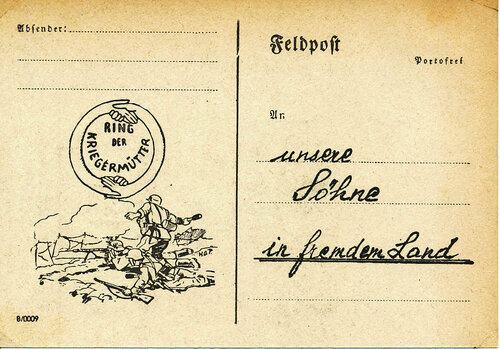
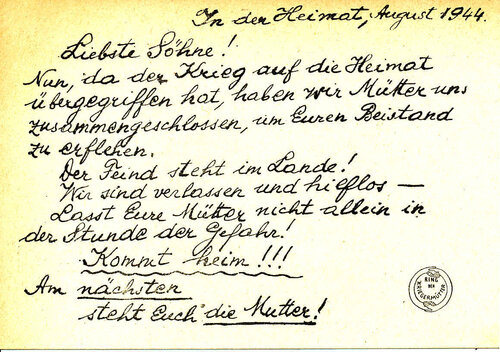
Card 3B
Above the three infantrymen is the seal of the Ring der Kriegemütter(War Mothers' Group). The card is addressed to:
Our Sons in foreign Lands
The message side is identical to Card IC:
From the Home Front, August 1944.
Dear Sons! Now that the war has reached the home front we mothers have united to beg you to assist us. The enemy is in our country! We are abandoned and helpless. Do not leave your mothers alone in the hour of danger. Come home!!! Your mother is nearest and dearest to you!
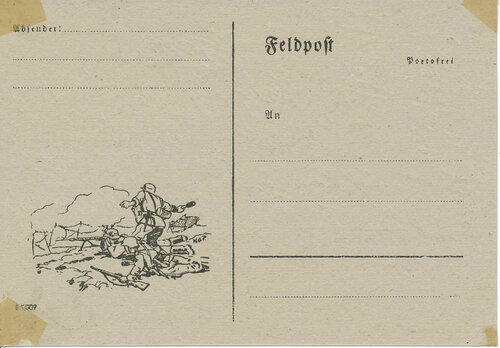
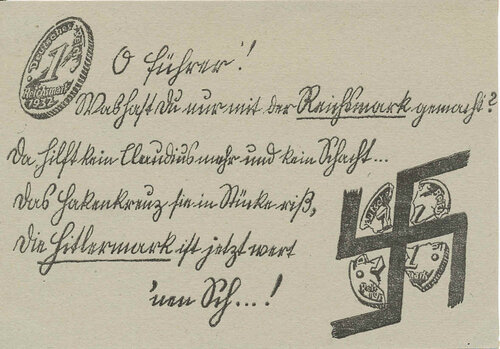
Card 3C
Three German infantrymen at the lower left. No text or additional symbols on the address side.
The message side is identical to Card 2C - the two Reichsmark coins and the text. The card is on gray paper: The text is:
O Fuehrer!
What have you done with the Reichsmark?
No Claudius and no Schacht can help you.
It has been torn in pieces by the swastika.
The Hitler mark is now worth sh..!
A Mortar Team
The fourth military vignette shows two soldiers on the ground. One is aiming a mortar shell while the other seems to be working on an ammunition box. There are only two propaganda postcards in this set.
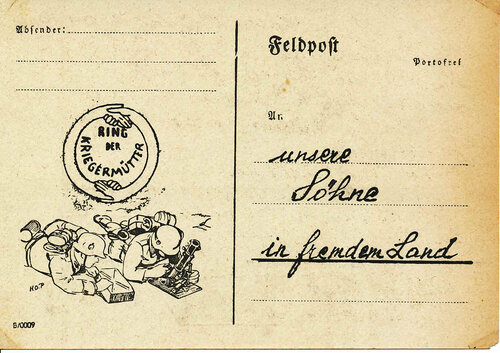
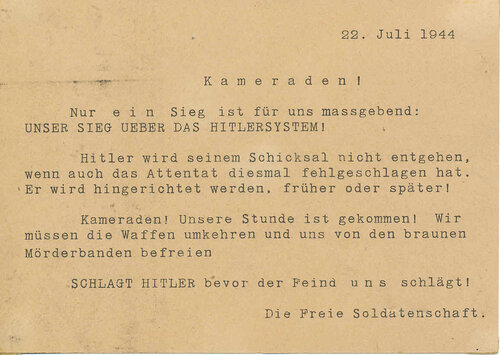
Card 4A
A two-man mortar team at the lower left. Like Card 1C, this card bears the seal of the War Mothers' Group and is addressed to:
Our sons in foreign lands
On the message side is a simulated handwritten message:
From the Home Front, August 1944.
Dear Sons! Now that the war has reached the home front we mothers have united to beg you to assist us. The enemy is in our country! We are abandoned and helpless. Do not leave your mothers alone in the hour of danger. Come home!!! Your mother is nearest and dearest to you!
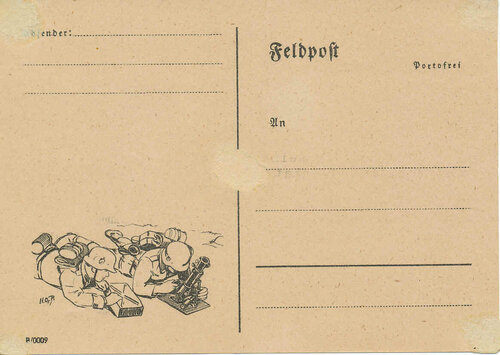

Card 4B
A two-man mortar team at the lower left. No text or additional symbols on the address side.
On the message side a typewritten message reads:
22 July 1944.
Comrades! Now only one victory is important to us. Our victory against the Hitler system. Hitler will not be able to escape his fate. Even though the latest attempt has failed, he will be executed sooner or later! Comrades! Our hour has arrived! We must now turn our weapons around and rid ourselves of the brown murderers. Defeat Hitler before the enemy defeats us!
The free Soldiery.
Although the July 20 assassination attempt has failed, this card attempts to convince the Army to stage a premature revolt against the Party leaders, one that would have surely led to even greater torture and death at the hands of Himmler's SS.
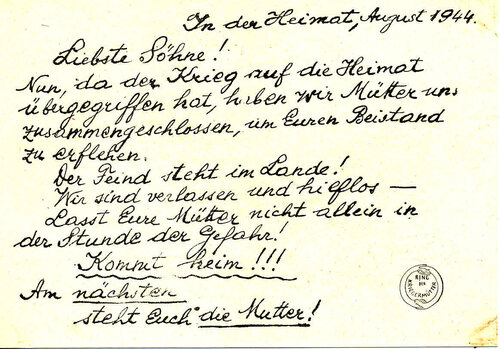
Card 5A
Three anti-aircraft gunners at lower left. Like Card IC, the address side shows the War Mothers' Group seal, and is addressed to:
Our sons in foreign lands
On the message side is a simulated handwritten message:
From the Home Front, August 1944.
Dear Sons! Now that the war has reached the home front we mothers have united to beg you to assist us. The enemy is in our country! We are abandoned and helpless. Do not leave your mothers alone in the hour of danger. Come home!!! Your mother is nearest and dearest to you!
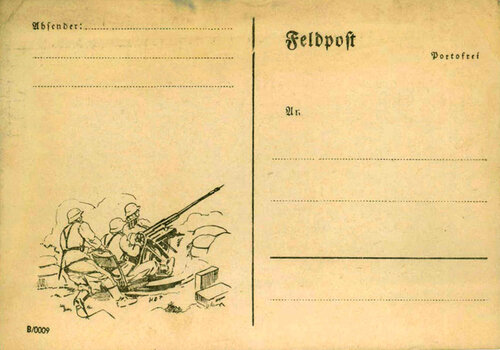
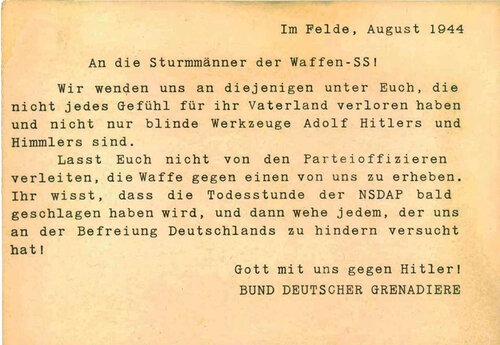
Card 5B
This is another OSS postcard that suddenly appeared in December 2016. It is amazing that these cards can exist for over 70 years and just be found. That does speak for their rarity, maybe just one or two taken as a souvenir by some OSS agent that wanted a souvenir of his past. On the front, the card depicts three anti-aircraft gunners at lower left.
The back is all text with the message the same as Card 2A:
In the field, August 1944.
To the storm troopers of the Fighting SS!
We address ourselves to those among you who have not yet lost every feeling for their Fatherland and have not become blind tools of Adolf Hitler and Himmler.
Do not let the Party officers mislead you and induce you to take up arms against us. You know that the death knell of the National Socialist Party will soon sound. And then, woe to those who have tried to prevent us from liberating Germany.
God be with us against Hitler!
Federation of German Grenadiers.
The Dornier Do-215 Bomber
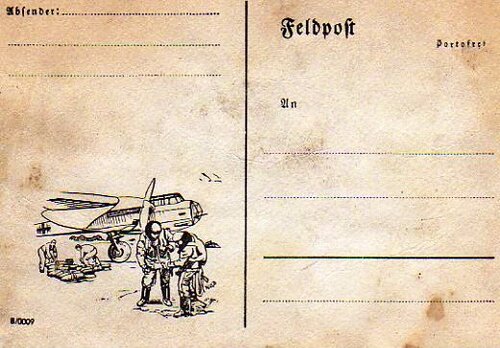
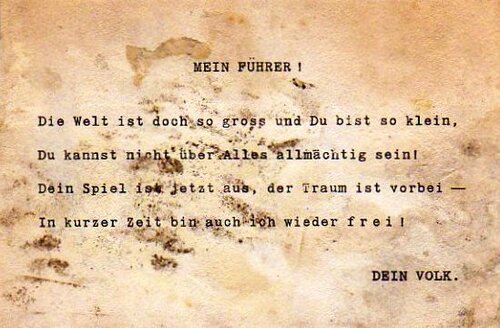
Card 6A
There is only one known OSS propaganda postcard that depicts the Dornier Do-215 bomber at the lower left. It was not in the original MO scrapbook from where the other cards came, but instead showed up at an auction of Rome OSS material in 2010. In the lot were also eight of the OSS gummed propaganda stickers, a standard OSS leaflet, a souvenir North African banknote and a preprinted envelope from an Italian Fascist organization which could be genuine or could be an OSS forgery.
A personal letter without envelope found with the items signed “Dad” showed that the owner had been an unnamed officer in Washington DC in May 1944 and was awaiting orders to fly to Algiers. The OSS had moved their headquarters from Tangiers to Algiers in November 1942. Rome was liberated 4 June 1944 and the OSS had an outpost there immediately afterwards.
There were also some military newspapers found with the lot, such as the United Nations News Service Basic News of 28 April 1945, from PWB Unit 14, APO 512. That APO was in Algeria in 1943. By 1945, APO 512 was in Rome. Also found was a Psychological Warfare Branch Official Communiqués newsletter dated 27 April 1945 and two congratulatory letters from General Mark Clark addressed to a Colonel John Riepe. John Riepe was the Commander of the 2677th OSS Regiment in Rome in 1945. When we put it all together; the names, places and dates, it appears that the Dornier propaganda postcard was from the personal papers of the former commander of the Rome OSS Regiment.
[Note] when I was researching this postcard I actually found that the two letters mentioned above had been auctioned and sold for $60. The lot said in part:
Two signed letters from General Mark W Clark (commander of the WWII Italian Campaign) to Colonel John H Riepe (Commander of OSS operations with the Italian Partisans) dated 1946 and 1947.
The front of the postcard is similar to all the other military postcards and depicts two of the flight crew checking each other’s parachutes while in the background two ground crew members load bombs into the Dornier bomber
There is no text on the address side.
The message side bears a typed text:
My Leader!
The world is so big and you're so small,
You cannot be omnipotent over everything!
Your game is now finished, the dream is over --
In a very short time I'll be free again!
Your people.
A FORGERY OF THE MILITARY CARDS
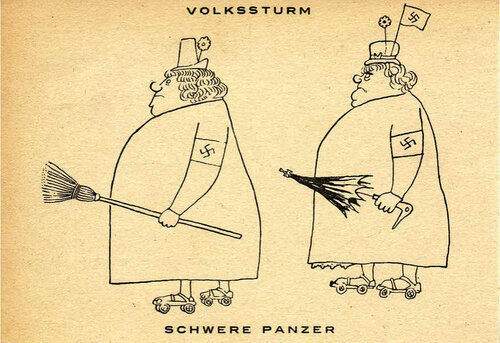
The Volkssturm/Schwere Panzer front
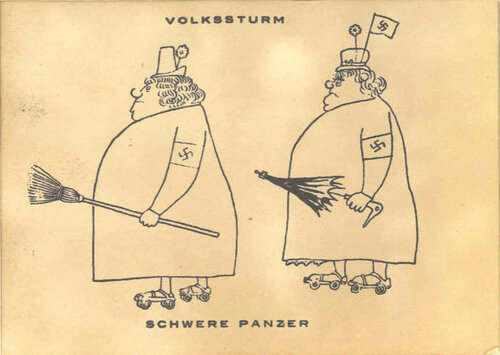
The Volkssturm/Schwere Panzer Fake front


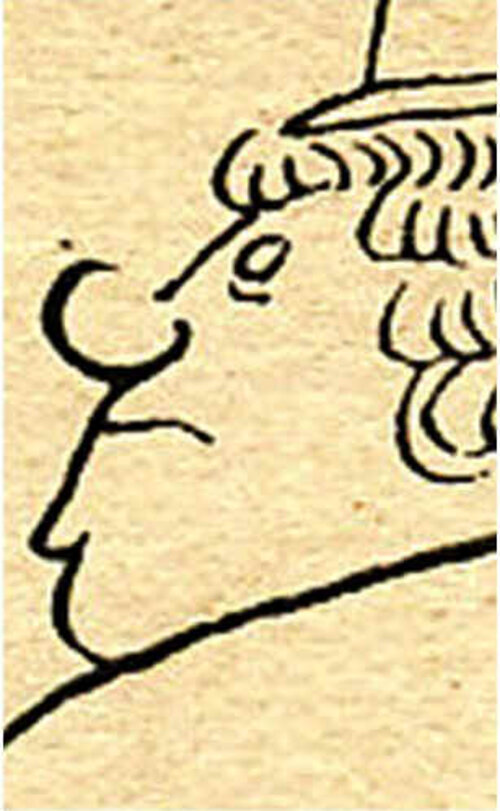
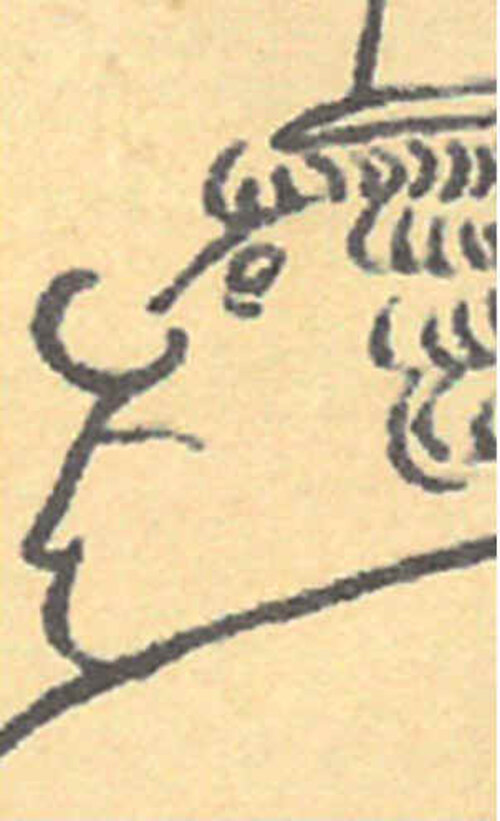
Note the lines of the fake are less sharp than the original
In 2019, German researcher Wolfgang Baldus identified a forgery of one of the OSS military cards. The forgery had the Volkssturm / Schwere Panzer image of Card 1A on the front. The back of the forgery has the Hitler is on his deathbed message found on the back of OSS card 1D. The fake image is actually pretty good. The ink lines seem just a bit less sharp than the original and perhaps a tad thicker. Wolfgang examined the card and told me:
The amazing thing is that illustrations of genuine cards that were printed in an article or an auction catalog are screened and must show under magnification the screen dots of the printing process. There are no screen dots in the card. The forger could not have scanned or photographed an illustration of a genuine card published anywhere; he must have used genuine cards (1A and 1D) or scans or excellent photocopies of genuine cards. The forgery resembles a digital print, which would make it a modern forgery. But what is puzzling me is that the cardboard looks old and the card has the toning along the edges you can often see on old cards that slept in a pile of cards for many years. Modern or not, my card was not printed from the same plate as the genuine card and as long as we don´t believe that the OSS made several plates it must be a fake.
THE CITY CARDS
Each OSS propaganda postcard in this category depicts three cities. Three different types are known but all are similar in appearance. The size is 148 x 103mm. These are on heavier card stock than the military types. All three have a bright blue background. These propaganda postcards were produced by the OSS MO office in Rome.
Each card shows oval portraits of three German cities. Behind the cities, the blue background shows the moon and stars with a cat singing in the darkness. Below the scene there is a message that is a parody of an old German lullaby. Instead of a gentle song to aid sleep, the OSS has written a dirge that tells of bombs and destruction intended to weaken the German willingness to carry on the war. All three cards have identical text:
Tired am I, I'm going to rest,
Aircraft spotter, let your eyes
protect our little city.
What the enemy has done to us.
Dear God, just look at it!
Your grace and our courage
will repair all damage.
Many that are known to us
had their houses burnt
And so large and small
have mostly rubble and no home.
Let the Moon stand in the sky
and reveal the desolated city.
Yes, and all this we have only you to thank,
Our dear little Fuehrer!
In German the message is quite lyrical.
The three cards appear identical at first glance, although a closer look reveals the following differences:
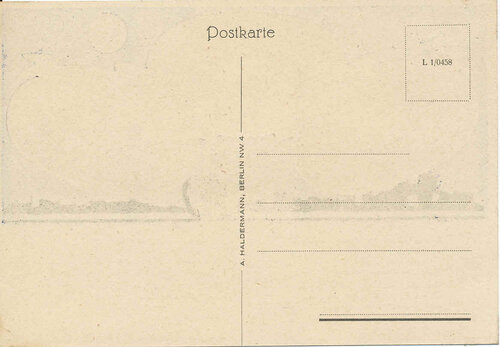
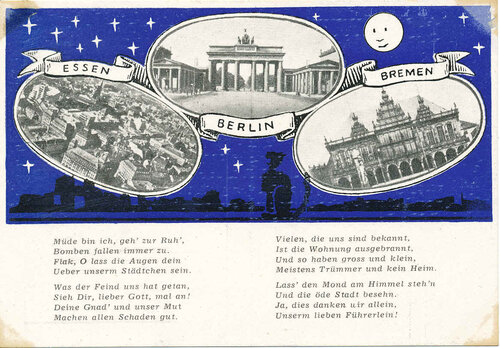
Card 7A
ESSEN —BERLIN —BREMEN: the box for the stamp contains the text “L 1/0458.”

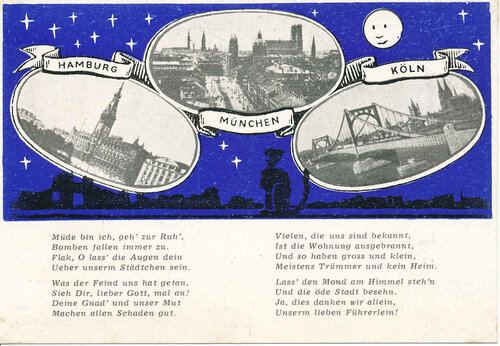
Card 7B
—MONCHEN—KOLN: box for the stamp contains the text “L 1/0458.”
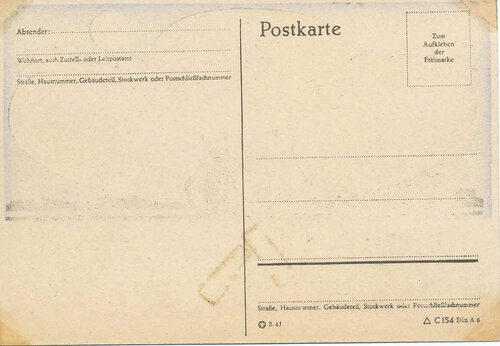

Card 7C
HAMBURG —MONCHEN—KOLN: the box for the stamp contains the text Zum Aufkleben der Freimarke (stick on postage stamp); and at lower right is the code “C 154 Din A6.”
OSS ANTI-JAPANESE BLACK POSTCARDS
The OSS did prepare some black postcards for Japan, but not nearly as many as aimed at the Germans.
Some of the black postcard work is mentioned in Ann Todd’s book: OSS Operation Black Mail – One woman’s covert War against the Imperial Japanese Army, Naval Institute Press, Annapolis, MD, 2017. The author talks about Elizabeth “Betty” McIntosh, one of the female OSS agents sent to the China-Burma-India Theater of Operation.
Major William Clark held the keys to the Morale Operations kingdom in the form of captured Japanese printed material: letters, postcards from home, diaries, field manuals, magazines… He would allow Betty to dip her hand into some damp sacks recently captured in the jungles of Burma. The bags held “pitiful momentos”—family photos, good luck charms, letters, and wrapped stacks of clean, dry postcards. Betty had no trouble reading the simply scrawled messages, many in pencil. All were stamped with an Imperial Army post office star and censor’s chop. The men of the Mori unit Higashi tai had written a total of five hundred postcards on the eve of battle at Myitkina.
Betty suddenly saw the possibility of her first feasible operation since she had arrived in CBI. They could erase the penciled colloquial kanji script and substitute different messages. If they could get the cards in the mail and past the censors, this would be the first black MO to make its way into the heartland of Japan. “It’s a cinch,” Bill said. “Our 101 agents can slip this mail pouch into the Jap postal system that’s still working south of Mogaung—there’s a damned good chance nobody’ll check cards that have already been censored!” Betty agreed on several common themes for the altered messages for the folks at home in Japan: the IJA in Burma was underequipped and being defeated; U.S. bombers passed overhead daily to mass for bombings of Japan, and soldiers were unsettled by rumors of strikes on the home islands. Underlying message: The war is lost.
These operations are also mentioned by Dr. Troy J. Sacquety in his article “Setting the Rising Sun - The WWII service of Psywarrior Elizabeth McIntosh” published in VERITAS, Vol. 12, No. 1, 2016:
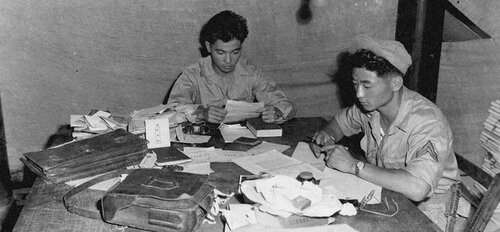
Nisei soldiers at Detachment 101 work on a Morale Operations Project.
The documents and Japanese dispatch cases are similar to those utilized
by McIntosh in Detachment 303. (Photo courtesy of Veritas magazine)
In another example, the Detachment 303 MO section discovered several hundred farewell postcards handwritten and addressed by Japanese soldiers. The cards had already been censored by the Japanese, but had been captured before they made it into the enemy mail system. The MO section, with the help of OSS Nisei (Japanese-American personnel), erased and rewrote the letters. The ‘new’ postcards now had anti-patriotic messages that asked their families at home why they lacked supplies at the front while telling them about “heartbreak and starvation in the jungles.” Once rewritten, Detachment 101 used its agent network to insert the postcards back into the Japanese mail system to directly penetrate Japan proper with a message of despair from the edges of the Empire.
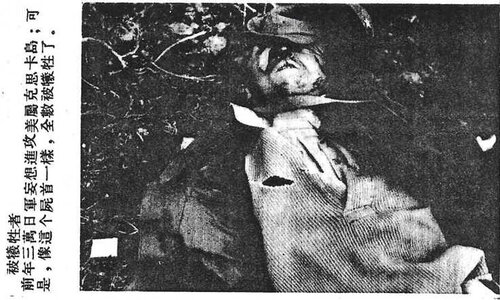
A Postcard from the Greater East Asian War Folder
This postcard shows a dead Japanese soldier on the field of battle in the Aleutian Islands with the text:
Sacrificed. The year before last 30,000 Japanese soldiers attempted in vain [recklessly] to conquer the Island of Kiska which belongs to the United States of America. just like this corpse, they were all killed.
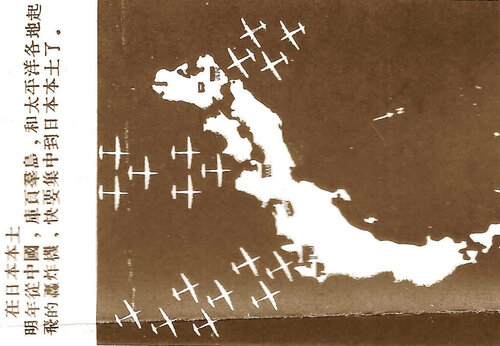
A Second Postcard from the Greater East Asian War Folder
Variations of this image were used quite often on American propaganda. It depicts squadrons of B-29 heavy bombers on their way to bomb Japan. The text is:
Over the Japan home islands: The bombers flying from China, the Islands of Sakhalin and places all over the Pacific will concentrate over Japanese home islands next year.
On another occasion the OSS actually prepared a folder of pictorial postcards that depicted cheering Japanese soldiers, aircraft surrounding Japan, Japanese prisoners-of-war, and scenes of dead Japanese soldiers on the battlefield. The folder was entitled “A Short pictorial History of the Greater East Asian War.” The folder was designed to raise the morale of the Chinese that were fighting the Japanese. The postcards could be removed from the folder and told the story of Japan’s timetable for defeat tracing military losses from Kiska in 1942 through 1944 when the massive Allied bombing of Japan began.
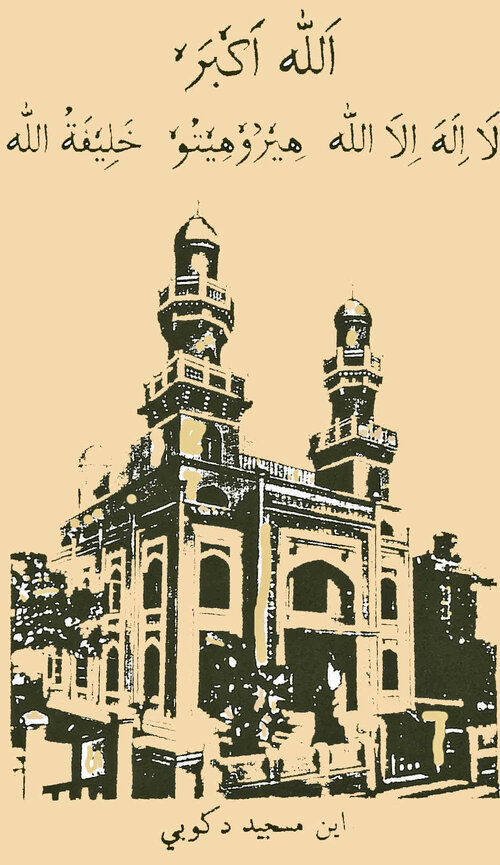
An OSS Anti-Japanese Postcard for the Muslim of Sumatra
The OSS produced a “black” postcard for the Muslims of Sumatra that was intended to infuriate them. On the front it depicts the Mosque in Kobe, Japan. Above the picture there are two lines that state:
Allah is God
Hirohito is his Prophet.
On the back of card written in Japanese, Arabic and Indonesian is:
The Unity of Islam and Shinto can be seen here.
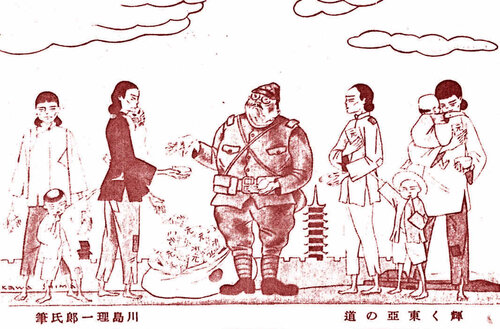
The Glorious Co-Prosperity Sphere Postcards
Colonel K. D. Mann, Chief of the OSS Morale Operations group in Calcutta, sent a letter to Captain Oliver J. Caldwell in China dated 15 April 1945. He says in part:
Don Monroe copied these [two] cards from an authentic one sent to us…We intend to write poison pen messages on these cards, stamp them with the censor’s stamp and will then send them on to you for distribution.
There were two postcards attached to the letter, depicting a fat Japanese soldier and Chinese women and children. In the first the Japanese soldier holds struggling children. In the second he has a bag of money and Chinese woman give him their money in return for a little rice. The title of the card is:
The Glorious Co-Prosperity Sphere
THE OSS – OWI POSTCARDS
The OSS prepared at least two colorful propaganda postcards attacking the Axis in conjunction with the U.S. Office of War Information. All the reference material says that the cards were an OWI project, but both of these cards have been found with OSS letter file codes stamped on them, so there is some question about whether it was the OSS or OWI really behind this project. Both cards were prepared in Bern, Switzerland about 1943 and feature vignettes by the famous Polish caricaturist Arthur Szyk. Syzk had authored a book of his anti-Fascist caricatures called The New Order in 1941. In it, he printed 38 of his illustrations. Both Colliers and Esquire Magazine used some of Szyk’s drawings as cover illustrations. Esquire also printed six full-color postcards featuring the drawings of Szyk in June 1942. The set was called the “Esky Cards” I first wrote about these in my article “The American Propaganda Postcards of WWII,” German Postal Specialist, February, 1987. I only had black and white photocopies of these extremely rare cards but when they were prepared by Szyk they were printed in full color. We know from OSS files that 55,000 copies of each propaganda postcard were printed in Switzerland.
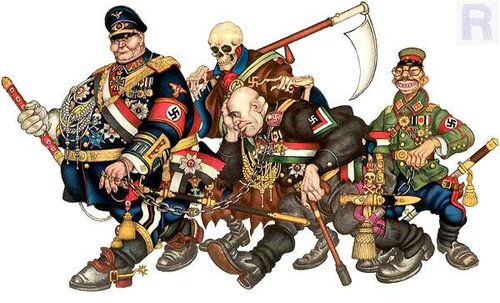
Pact of Steel
The first card depicts Hermann Göring, Hideki Tojo, and the Grim Reaper leading a chained and reluctant Benito Mussolini. Notice that the Japanese leader Tojo wears a Nazi Party swastika armband. This vignette was originally on a 1942 Szyk Esquire Magazine 4.6 x 7-inch postcard; (Set 6 - Esky No. 3) entitled “Il Duce.” The title Stahlpakt (Pact of Steel) is on the back of the propaganda postcard along with the code “TDWD.” The Esky cards were in English. The OWI cards have German captions, possibly to imply that they were produced by an anti-Fascist movement within Germany. The military “Pact of Steel” between Germany and Italy was signed on 22 May 1939. Although these cards are usually considered to be products of the Office of War Information, the OWI and the OSS often shared the same printing plant in Switzerland. The OWI printed white propaganda during the day and the OSS secretly printed black propaganda after dark. They had to be very careful because Switzerland was neutral and the Swiss police often raided the printing plants. This card has the stamped OSS file code “R.” The OSS started using an alphabetic code and quickly used up the letters “A” to “Z” They then changed to a numeric code and further leaflets in the series are coded from 1 to 341 (the highest number I have seen so far).
An almost identical postcard was found in France. There is no text on the front and no code on the back. The address side is printed at the top “Carte postale.” At the bottom left we find the printer “C. G. & Cie.” This company is unknown in the directory of French postcard producers. The card bears a cancellation from the liberation committee of Annemasse, a small town southeast of Geneva but across the French border. Annemasse was liberated on 8 August 1944. The size of the card is 15.4 x 10.8 cm. This card might have been printed by the Allies for the French, or some patriotic Frenchman or company might have copied an OSS-Szyk card to produce his own “French” stock.
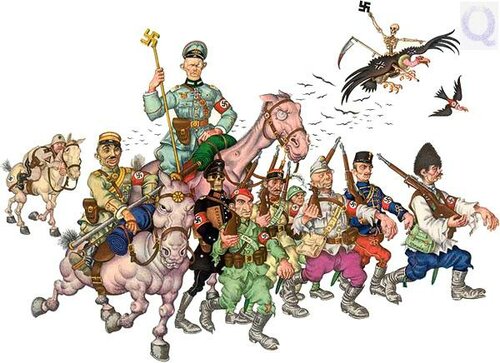
Triumphal Procession
The second card depicts two individuals wearing swastika armbands riding on horseback. Traditionally they have been identified as Heinrich Himmler and Hideki Tojo but closer inspection shows that the “Himmler” figure is wearing a Wehrmacht uniform and an Iron Cross rather than SS paraphernalia so it is more likely that this is someone like Field Marshall Wilhelm Keitel, head of the Oberkommando der Wehrmacht (High Command of the Armed Forces). The Tojo figure again wears a swastika, but the indications that he is Japanese are the Imperial chrysanthemum crest on the horse’s bridle and the samurai sword he carries. Mussolini lags far behind on what may be a mule. In front of the Axis leaders we see various collaborators and puppet troops being forced toward the war zone by a Gestapo member. Hidden away on their armbands, saddle bags, belts and even one animal’s body are tiny German words that identify the individuals and their nations: “Spain;” “Hungary;” “Romania;” “Italian;” “Japan;” “Gestapo;” “Vichy;” and “Finland.”
Overhead a symbol of death holding forth a swastika sits astride a vulture. There is no text on the front, but the back is entitled Triumphzug Unter den Linden Berlin 1943 Triumph [or Triumphal Procession] under the Linden Trees, Berlin 1943) and the code “RLD.” The Unter den Linden is a wide boulevard in the Mitte district of Berlin built by Frederick the Great in the mid-1600s that went westward from the palace. An old woodcut shows the avenue is already tree-lined while everything behind is a wasteland under construction. It is named for its linden (lime) trees that line the graced pedestrian mall and was sometimes used by the Nazis to stage parades and marches. The vignette was originally on a Szyk Esquire Magazine 4.6 x 7-inch postcard (Esky Set 6 - No. 2) entitled “The New Orderlies.” The OWI/OSS stamped file code for this propaganda postcard is “Q.”
Both illustrations depict Mussolini as a weak and ridiculous leader. The OWI/OSS selected these pictures to discredit the German-Italian alliance and to divide both countries.
A French Szyk Postcards
Wolfgang Baldus reported in 2014 that two postcards with the French words CARTE POSTALE and the imprint “C. G. & Cie” were found. They are almost identical to the two OSS cards. It was first suspected that these “French” varieties were also produced by the OSS, i.e., that the same printing plates were used. However, close examination showed some minor differences that indicate that the French cards are not completely identical to the known OSS cards. They clearly were used as a model the French cards. According to German examiner Roland Pieles, the paper used for both the OSS and the “French” cards is identical. Thus, it is possible that the “French” cards are OSS products although they are not mentioned in OSS files. The alleged printer of the French cards is “C. G. & Cie.” They are unknown and possibly an invention of whoever printed the cards, a French forger, or the OSS.
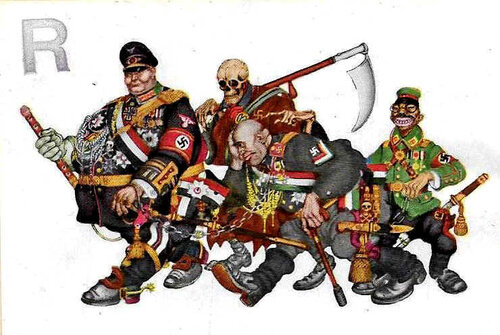
The “Pact of Steel” gummed label
I should mention that both of these images were also printed on gummed labels reduced in size to be placed on walls, tables, and wherever Germans might congregate. I depict a gummed sticker from a Berne sample book. The Propaganda cards measure about 6 x 4-inches, while the propaganda gummed labels measure about 3.75 x 2.5-inches.
There is one peculiar fact about these two cards and gummed labels. Every specimen I have seen depicts “Pact of Steel” as “Q” and “Triumphal Procession” as “R.” However, some documents indicate that they are stamped incorrectly and “Pact of Steel” should be “R” and “Triumphal Procession” should be “Q.” I do not know how such a mistake could be made, but I do note that in the official OSS file books the “R” appears before the “Q: so perhaps that indicates that the OSS was aware that they had erred.
THE “SIGN OF LIFE” CARD
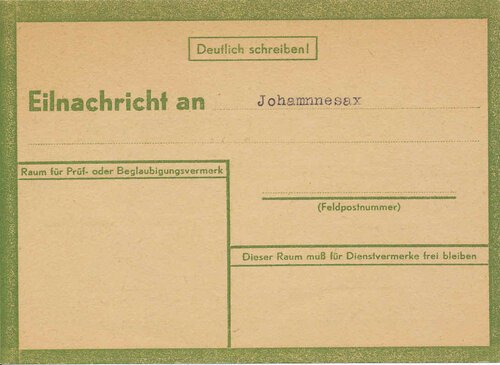
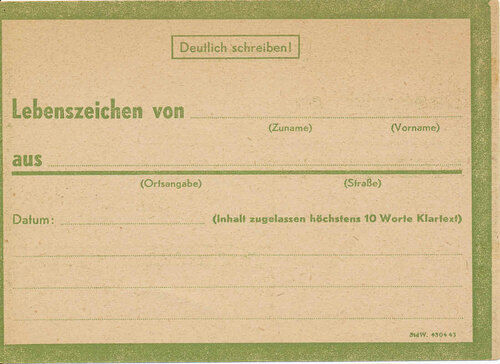
Genuine "SIGN OF LIFE" Card
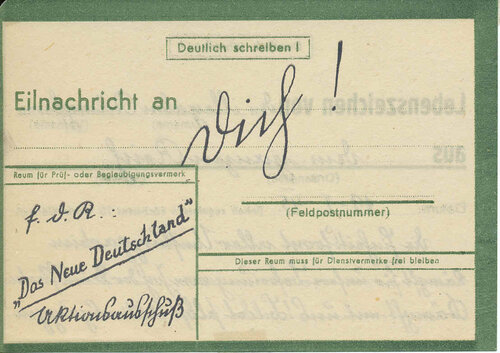
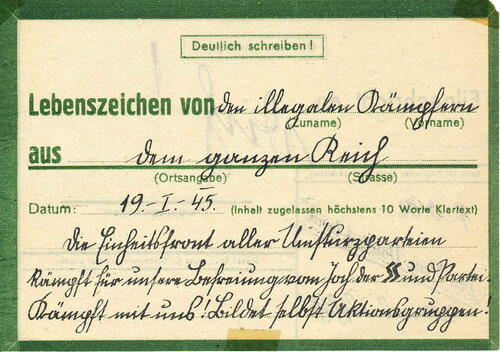
OSS Forgery of "SIGN OF LIFE" Card
There is another type of postcard that could be sent through the mail. It is not exactly a postcard, but instead a reproduction of the official German form used to notify relatives of survivors of allied bombings. In 1943, the German Reichspost released special postcards that allowed victims of bomb attacks to send a short message to their relatives. Three versions differing in color and design were printed. They are inscribed “Lebenszeichen von” (Sign of life from) on one side, and “Eilnachricht an” (special message to) on the back. All have a broad color frame around the margins. Red cards were for private addressees, green cards for soldiers with field post numbers. Violet cards were used by the Reichspost to check the postal addresses of people living in so-called “Luftnotgebieten” (emergency zones).
This form, often called a “Sign of Life,” might be sent to a serviceman from Berlin or Cologne to inform him that his parents were alive and well after a severe bombing raid. These forms usually passed through the German post at no cost to the sender. They normally bore no cancellation, although they were sometimes censored.
The MO Unit in Rome forged the green version of the sign-of-life card. The forgery is inscribed in German in carefully handwritten Gothic script. On the address side where the genuine card says “Express to” the OSS added the word “you!” At the lower left, they added the text “F.D.R,” short for “für die Richtigkeit,” (“for the correctness”). It was used in the war years by persons who were authorized to sign letters on behalf of their superiors. Beneath those words is the text: “The New Germany, Action Committee.” "The New Germany"(Das Neue Deutschland) was the name of the OSS propaganda newspaper printed and dropped over Germany.
The message side bears a longer propaganda text, Sign of life from:
The Illegal fighters – in all the Reich
The card is dated “19-1-45.” The propaganda message on the card is:
The United Front of all revolutionary parties fights for our liberation from the yoke of the SS and the Party. Join us in the struggle! Form your own action groups!
Examples of this card were found on the dead German soldier in Italy.
The Postcard Values
I want to take a moment to discuss the value of the individual postcards. Since they are extremely rare, most just a single copy outside government archives, they are obviously quite valuable. In fact, they have only been offered at auction a few times. One problem is that they are so rare that most bidders do not recognize what they are. The cards appear at auction with other WWII philatelic material and I suspect the average buyer thinks it is a genuine German postcard. Remember, genuine German postcards do exist with the very same vignettes on the front.
The owner of the Allen scrapbook wanted to test the market so put one of his duplicate cards 3C up for auction in Hamburg, Germany on 6 to 9 October 1993. As Lot 1815, it was described as “Propaganda card grey paper inscribed “Feldpost portofrei”, at left picture of infantry and code No. B/0009. On the reverse "O Führer!..." Item for the specialist in very good quality.” The card sold for 1200 German marks, the owner eventually receiving $502.
A Japanese collector stated that he had seen one of the OSS propaganda postcards sold recently in a European gallery for 450.00 Euros (about $613 U.S. dollars). I do not know what card that might be and am unable to find out any information about this sale. This could actually be the 3C card from the Allen scrapbook being resold, but I have no way to verify that.
Most recently, in February 2010, one specimen of card 6A was sold at auction in the United States for $387 dollars. The dealer did not specify that this was an OSS propaganda postcard so it is likely that other bidders did not recognize its rarity.
If any readers have seen these OSS postcards for sale I would appreciate it if you would send me a note at the address below with all the pertinent details.
These are all the black postcards presently known to have been prepared by the propaganda agencies of the United States against the Germans. There are many more postcards prepared for use against the Japanese, but that is for another story.
THE OSS PROPAGANDA LETTER SHEETS
The OSS produced more than just propaganda postcards. They also produced a number of propaganda leaflets in the form of folded letter sheets. Only a very few of these have survived the war. Those illustrated were found in reference collections kept by former members of the Office of Strategic Services.
There are eight letter sheets in all. A ninth one is rumored to exist but I have not seen it. Two of them are rectangular with a printer's imprint of "Robert Franke" on the address side and normal lines for addressee and sender. The code E/0483 appears at bottom right on the address side. These smaller letter sheets are designed to be closed with a single fold. The six larger letter sheets have no text on the address side except for the word "Feldpost," and were cut with a flap where normally the glue would be applied. Some of the filed letter sheets are found without the flap so it is apparent that they were either removed for some unknown reason, or printed both ways. I believe that all the letter sheets originally had the glue flap. This second type of letter sheet was designed to be closed with three folds. Many of the sheets have discoloration around the border and this was caused by the use of tape to mount the leaflets in the specimen scrapbook.
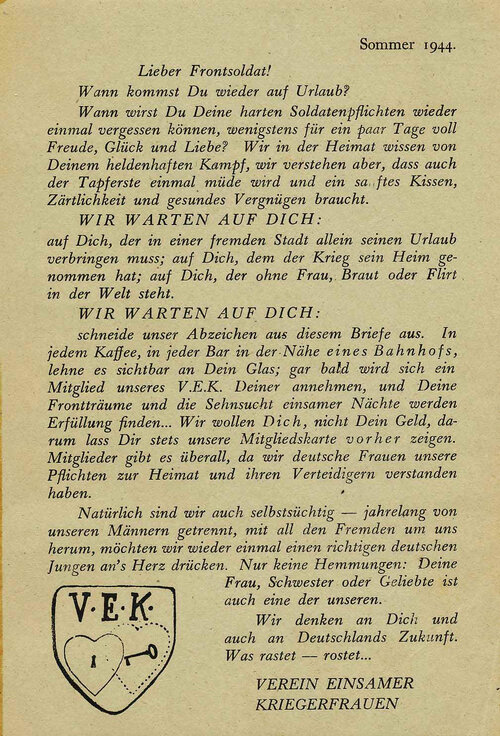
Dear Soldier at the Front
One interesting specimen meant to destroy the morale of the frontline soldier was carefully worded to make him believe that his wife, sister, or mother was having casual sex while he was stationed at the front. This letter sheet measures 139 x 195mm and is printed on yellowish paper in 1944. It was cut rectangular, without a glue flap. It bears the imprint:
Spezial-Verlag Robert Franke, Hamburg 36 Gesetzlich geschutzt. DRGM Nr. 1518771 u. GM. Nachahmung verboten. E/0483
Curiously, there was actually a printer by this name in Hamburg, and the OSS obviously used his name in an attempt to make the letter sheet appear genuine. On the back of the sheet a printed message in German says:
Summer 1944
Dear Soldier at the front.
When will you have leave again?
When will you be able to forget your arduous soldiers’ duties for a while, at least for a few days of fun, happiness and love? We at home know of your heroic struggle. We understand that even the bravest gets tired sometime and needs a soft pillow, tenderness and healthy enjoyment.
WE ARE WAITING FOR YOU:
For you who must spend his furlough in a strange city, for you whom the war has deprived of a home, for you who is alone in the world without a wife, fiancé or girl friend.
WE ARE WAITING FOR YOU:
Cut our symbol from this letter. In every cafe and bar in the area of the Railway station, place it on your glass so that it can be clearly seen. Soon a member of our VEK will contact you. The dreams you had at the front, the longings of your lonely nights will soon find fulfillment. We want you, not your money. Therefore, let whoever approaches you show you her membership card. There are members everywhere, because we German women understand our duties to the Homeland and to its defenders.
Naturally we are also selfish. We have been separated from our men for many years. With all those foreigners around us, we would like once more to press a real German youth to our bosom. No inhibitions now: your wife, sister or beloved is one of us as well. We think of you and Germany's future. Which rests — rusts. [Use it or lose it.]
V.E.K.
The Association of Lonely War Women
At the lower left of the letter sheet is a small shield with two hearts inside, one with a key, one with a keyhole. The initials "VEK" representing the lonely women's group, this is the symbol that the soldier is supposed to paste on his beer glass. Of course, there was no such organization. This was simply an American attempt to convince German soldiers at the front that their women were lonely and no longer faithful. It is doubtful that many members of the Wehrmacht were fooled.
We do not know exactly how many copies of this specific letter sheet were printed, but a total of 66,000 field post letter sheets of various types were produced by the Rome printing plant of the OSS between July 15, 1944, and December 31, 1944. Total production by the end of the war was 287,000 letter sheets, with 257,232 actually distributed to the enemy behind the lines by various methods.
In 2015 a large collection of leaflets was offered for sale and the VEK letter sheet was included. The collection was formed by Corporal Arthur Baker whose discharge states:
Radio Operator – Served with the Office of Strategic Service for six months in Italy. Operated and maintained high speed radio equipment used code. Received and sent international Morse Code. Set up and maintained radio communications.
It appears that the corporal had nothing to do with leaflets, but like all Americans he was an avid souvenir collector and brought home about 30 of the Rome OSS Propaganda leaflets.
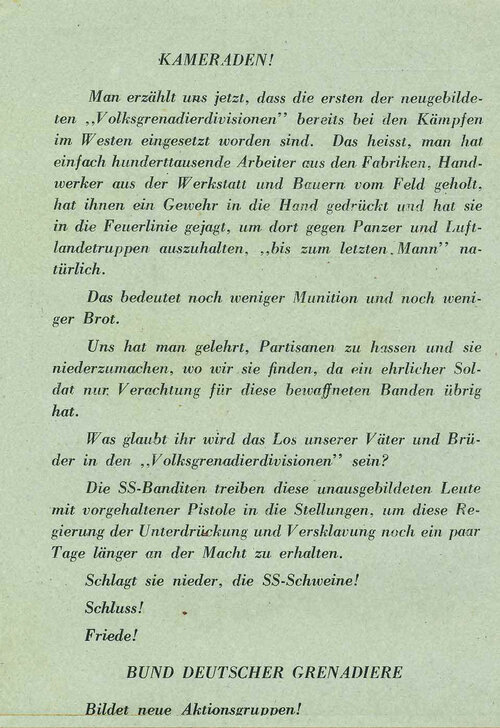

Comrades – People now say…
The first letter sheet on blue paper measures 138 by 195 mm. It is cut rectangular, without a glue flap. This letter sheet is printed on a blue-green paper. It bears the same printer’s imprint found on “Dear Solider at the Front,” mentioned above. 16,000 copies were printed in 1944. The message, reads:
Comrades!
People now say that the first of the newly formed “People's Grenadier Divisions” are already in place fighting in the West. That means that they have simply taken hundreds of thousands of workers from factories, craftsmen from workshops, and farmers from the fields, have put a weapon in their hand, and have forced them into the firing line, to hold out against tanks and parachute troops, to hold out "to the last man," naturally.
This means even less ammunition and even less bread.
They have taught us to hate partisans and to destroy them where we find them, since an honest soldier has only contempt for these armed bands.
What do you think the fate of our fathers and brothers in the "People's Grenadier Divisions" will be?
The SS bandits with drawn pistols are driving these uneducated people into the front lines to keep this government of oppression and enslavement in power a few days longer.
Strike them down, the SS swine!
End it!
Peace!
The Union of German Grenadiers
Form new action groups!
The veiled threat in this letter was the reminder that German troops were hanging partisans wherever found. The OSS implied that the Volkssturm, a military force under the control of the Nazi Gau leaders, was actually civilian in nature and liable to be executed upon capture as guerillas. The term "Gau" was the name given to the main administrative regions of the Nazi Party. This message certainly served to lower morale. In fact, the Volkssturm was never a fighting force in the true sense of the word, a case of too little, too late.
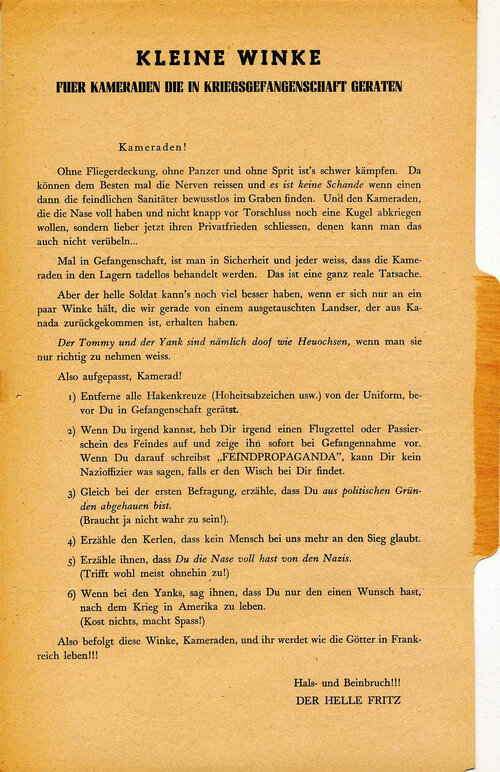
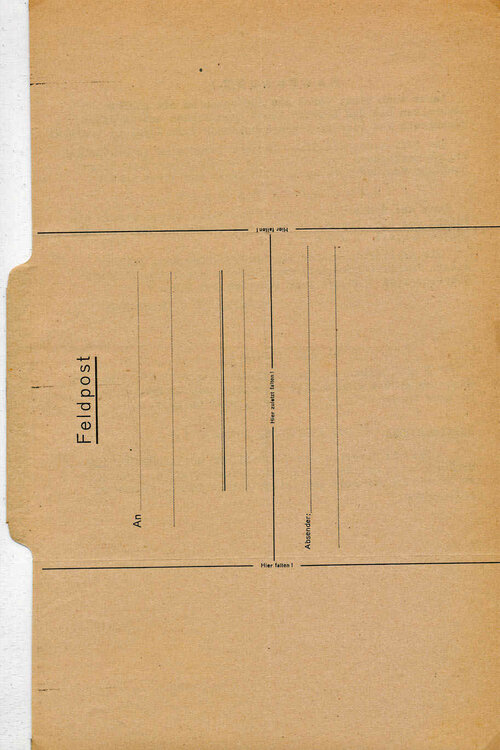
Little Tips
The message side has the following text, in German:
Comrades!
Without air cover, without tanks and without gasoline it is difficult to fight. Under those circumstances even the best can lose their nerve and therefore it is no disgrace if you are found unconscious in the trenches by an enemy corpsman. If some of you have had enough and don't want to catch a bullet just before the war ends, but would rather make their own personal peace treaty now, we can understand that you might be willing to take the necessary risks.
Once you are in captivity you are safe. We know that comrades in the camps have been excellently treated. That is a fact.
The bright soldier can do even better if he remembers a few tips which we have just received from one of our exchanged comrades who have returned from Canada.
The Tommy and the Yank are really stupid; you just have to know how to talk to them!
Listen Comrade!
Remove all swastikas and insignia from your uniform before you are taken prisoner.
If you can, save some leaflets or surrender passes that you have found and show them when you are taken prisoner. If you write “enemy propaganda” on the leaflets, then no Nazi officer can do anything to you should he find them in your possession.
During the first interrogation you should tell them that you have deserted for political reasons. (It doesn't have to be true.)
Tell them that nobody believes in victory anymore.
Tell them that you are fed up with the Nazis (Which is probably true anyway!).
When you are surrendering to the Yanks, tell them that you have only one desire after the war, to live in America. (It doesn't cost anything and it is good fun.)
Follow these hints Comrades, and you will live like Gods in France!!
Break your neck and leg!! [Good Luck!]
Clever Fritz
I suppose this leaflet served two purposes. First of all, the theme of the entire message is how stupid the Allies were and how well the surrendering German could live in captivity, which should have encouraged more Wehrmacht desertions. The second value is that, because the “clever” German has been told what he should say, anyone who used the hints in this leaflet was immediately exposed as being insincere. Although the OSS scrapbooks say that 15,000 copies were printed, a production report exists indicating that 21,000 copies of "K.W. Feldpost" were printed. The German language title of this letter sheet is “Kleine Winke,” (Little Tips), so it might be assumed that this is the item identified.
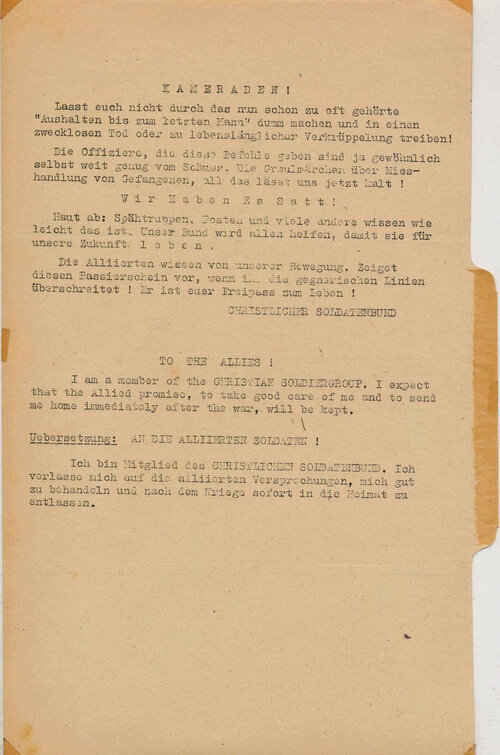
Comrades – Don’t let them…
Another letter sheet prepared by the OSS was printed on grayish paper and measures 180 x 295mm. The text is typewritten and faded, and looks almost as if it were mimeographed, as though it had been produced in the field under trying conditions, on clandestine equipment. The letter sheet is cut with a flap for pasting. 10,000 copies were printed in 1944. It reads, in German:
COMRADES!
Don't let them take advantage of you with that old slogan “Hold out to the last man,” and pointlessly be killed or crippled for the rest of your life.
The officers who give these orders are usually far from the shooting. All the grisly tales of mistreatment of prisoners leave us cold now.
WE HAVE HAD ENOUGH!
Cut off scouts, sentries, and many others know how easy it is. Our union will help everyone, so that they can live for our future.
The Allies know about our movement. Give them this pass if you cross into the enemy's territory. It is your pass to life!
CHRISTIAN SOLDIERS UNION
Directly below the text is a short message in both English and German. This is the "surrender pass" portion of the leaflet and reads:
I am a member of the Christian Soldiers Group. I expect that the Allied promise, to take good care of me and to send me home immediately at the end of the war will be kept.
OSS was telling Wehrmacht members that they would not be handed over to the Red Army. The OSS had no authority to make such a promise. That is why this leaflet was produced “black,” without identification of the origin. The OSS could lie, or make unofficial and misleading promises that were not binding on the American government or military. In fact, German soldiers from that area controlled by the USSR after the war were sent back to the east.
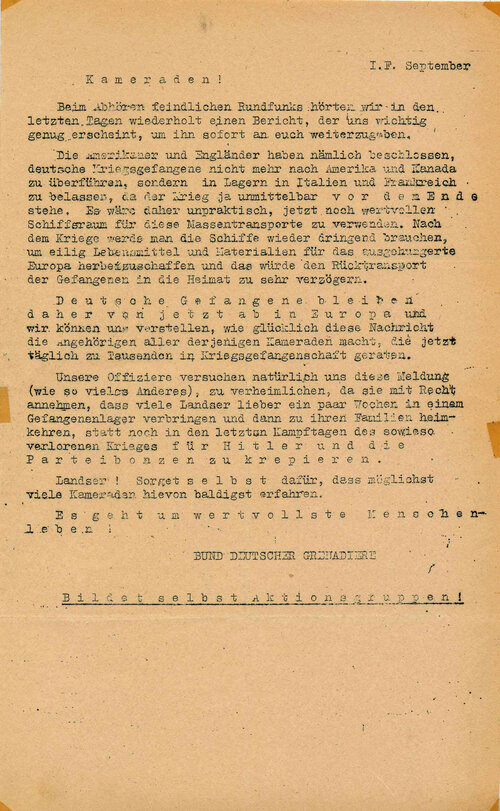
Italian Front – September
German soldiers’ preoccupation with where they would be sent as prisoners-of-war was used to advantage in another OSS letter sheet. Early in the war, numerous prisoners had been sent to camps in Canada and America. I have seen this letter sheet with glue flap and without glue flap. It tells the German soldier:
Italian Front, September
Comrades!
While listening to the enemy radio the last few days we have heard a report that seems important enough to pass on to you immediately.
The Americans and British have decided not to keep sending German prisoners of war to America and Canada, but to detain them in camps in Italy and France since the war is shortly coming to its end. For that reason it would not be practical to use valuable cargo space in ships for such mass transport. After the war ships will be urgently needed to bring food and materials to starving Europe and that would mean that the return of prisoners would be too severely delayed.
From now on German prisoners will therefore remain in Europe and we can imagine how happy this report will make all the relations of our comrades who are now being taken by the thousands into captivity as prisoners of war.
Naturally our officers are trying to keep this information (like so much else) from us, because they think, quite rightly, that many common soldiers would rather spend a few weeks in a prison camp and then return to their families than to perish for Hitler and the party bosses in the last days of a war that is already lost.
Infantrymen! You should all make sure that as many of your comrades as possible hear of this. This is a matter of precious human lives!
Union of German Grenadiers
Form your own action groups!
The OSS managed to insert a number of propaganda concepts into this leaflet: the war is over, and Germany has lost; America cares enough about the fate of the POWs not to delay their return home; and America fully intends to feed and rebuild Europe. That is quite a bit of propaganda to quietly squeeze into one message.
[Note] It is rumored that the same message as above “Italian Front – September” appears on a second letter sheet with the title: “Italian Front October.” We have not seen this alleged propaganda leaflet.

Italian Front – December 1944
This air letter was written by the imaginary Union of German Partisans. It was cut with a flap for pasting and printed in 1944. The text is:
Italian Front – December 1944
Comrade
German front line soldiers are speaking!
We recognized earlier than you that the Nazi bandits want to force us to continue the fighting, although they are well aware that the war is definitely over. However, they only want to save their own dirty skin. We infantrymen are meant to perish for Hitler and Himmler instead of living for a new Germany.
There is just one answer:
Come to us, comrade. We are among the partisans who fight for a new Germany. It is easy to find the way to us. You only have to turn to any Italian civilian and ask him to lead you to the partisans or show you the way since you intend to join him. This request in Italian is:
“Per piacere, indicatemi il modo e la via per unirmi ai Partigiani.”
Comrades who did this join us every day. They fight together with us for Germany’s freedom and for a future peace. We have enough to eat but bring your rifle and ammunition with you.
Come and help us comrade. It is for your future and for ours!
The Union of German Partisans.
This is an interesting propaganda message. First of all, any armed German soldier giving himself up to the partisans would probably be killed. Better yet, the OSS told the German defector to bring his weapon and ammo so that would immediately be confiscated by the Italians and turned against the occupying German Army.
Another letter sheet, entitled “Comrades, these are our Brave Allies!” is the only one to bear a vignette. A hairy ape wearing diapers and a German helmet stands right in the middle of the letter sheet.
There is an interesting story behind what was a continuing campaign to degrade foreign friends of the Third Reich. The German Army had recruited hundreds of thousands of foreigners to fight in various legions in what was called: “The war against Bolshevism.” In addition, many eastern European nations that feared the Soviets like Romania and Hungary had taken Germanys’ side and sent troops to fight alongside the Axis when it appeared the Third Reich would win the war.
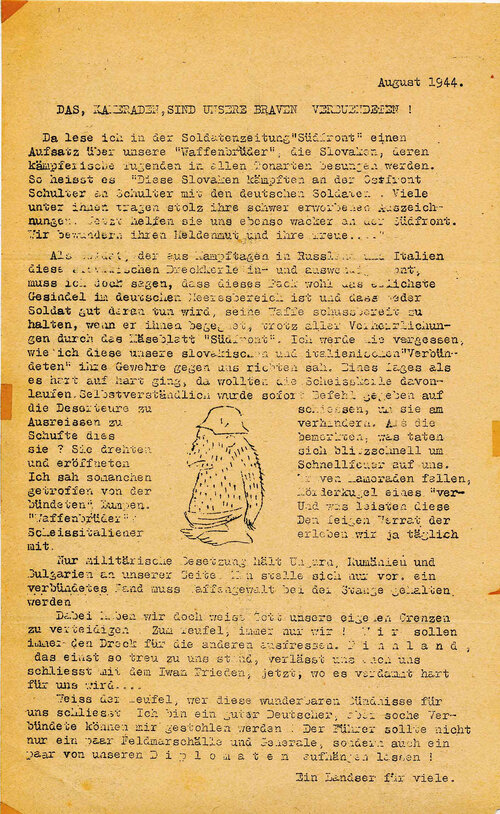
August 1944
The Americans, British, and Russians regularly produced propaganda that attempted to drive a wedge between the Germans and their partners. The British once dropped incendiary pens, with instructions to foreign workers on methods of sabotage. They didn't expect the pens to be used, they just wanted the Germans to distrust and harass their foreign allies and cause hard feeling. The British also produced pornographic leaflets that pictured dark foreign workers having sex with German women whose husbands were at the front.
The above OSS letter sheet was just another in a long line of attacks ridiculing allies of the Nazi movement. It attempted to destroy the morale of the Wehrmacht soldier by telling him how untrustworthy his allies were, while at the same time weakening the resolve of the foreign soldier by making him think his German friends had no faith in his ability or loyalty. Many Germans cheered when Italy surrendered thinking that they were better off without their weak partner.
The center of the message side contains a small caricature of an ugly ape wearing a diaper and a German helmet. I have seen the leaflet with and without the glue flap. A copy of this letter sheet was found in the United States National Archives within a section on British black propaganda, leading to the hypothesis that the U.S. Office of Strategic Services shared the printing plates with the British Political Warfare Executive. The text is:
August 1944…
THESE COMRADES ARE OUR WORTHY ALLIES!<
I'm reading an article in the soldier's newspaper “South Front” about our companions in arms, the Slovaks, and praises of their valor are being sung high and low. It says: “These Slovaks fought on the East Front shoulder to shoulder with German soldiers. Many of them wear their hard-won decorations with pride. Now they are helping us just as valiantly on the South front. We admire their heroic courage and their faith…
As a soldier who knows these Slovak dirty swine from days of battle in Russia and Italy, I have to say that they are the most disgusting riff-raff among the German Army. Every soldier is advised to keep his weapon ready to fire when he meets one of them, despite all the glorification by the local “South Front” rag.
I shall never forget seeing our Slovak and Italian allies turn their weapons upon us. One day in a tough fight these bastards tried to run away. The order was immediately given to shoot the deserters to stop their escape. What do you think those bums did? They turned around lightning quick and opened a rapid fire on us. I saw many good comrades fall, hit by the murderous shots of an “allied” tramp. What have these “allies in arms” achieved? Every day we see the betrayal of the damn Italians. It is only military occupation that keeps Hungary, Rumania and Bulgaria on our side. Imagine, holding an allied country by armed force. But, we have to defend our own frontiers. Damn it, why always us? It’s always us who have to eat the dirt of others. Finland, once so true, has abandoned us and is making peace with Ivan now at a time when it is about to get hard for us. The devil knows who makes these wonderful alliances for us. I am a good German, but such allies we can do without. The Führer shouldn't have only a few field marshals and generals hanged, but also some of our diplomats.
One soldier speaking for many others.
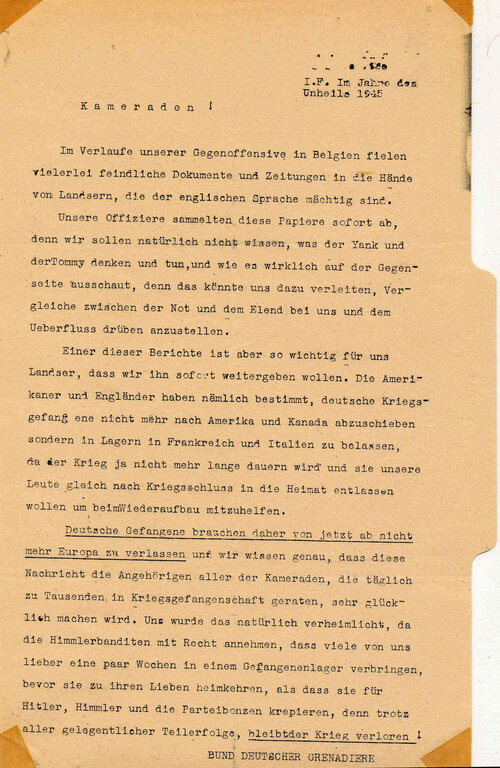
In the Year of Disaster - 1945
The above letter sheet appears to be printed during the battle of the Bulge. It mentions the fighting in Belgium. It has the glue flap and the text:
Italian Front - in the year of disaster – 1945
Comrades!
In the course of our counter offensive in Belgium various enemy documents and newspapers fell into the hands of soldiers who are familiar with the English language.
Our officers immediately confiscated these papers because they did not want us to know what the Yanks and Tommies think and do, and how it really looks on the other side. They did not want us to compare our need and misery with the affluence over there. However, one of these records is so important for us soldiers that we will forward it immediately.
The Americans and the British decided not to continue sending German prisoners of war to America and Canada but instead will allow them to remain in camps in France and Italy because the war is almost over. They intend to release our men in the homeland immediately after the end of the war to assist in the reconstruction.
From now on German prisoners will not be sent away from Europe. We know that this will make the relatives of all the comrades who are being taken by the thousands into captivity as prisoners of war very happy. Naturally, the news was kept from us since Himmler’s bandits, assume quite rightly that many of us would rather spend a few weeks in a POW camp before they return home to their dearest, then perish for Hitler and the Party bosses. Despite all minor successes, the war is lost!
The Union of German Grenadiers.
This is the second letter sheet that uses the promise of keeping the Germans close to home as a theme.
We don’t know much about the effectiveness of these propaganda letters. We know they were disseminated by the underground Maquis in France and by the partisans in North Italy. They were airdropped, taken into enemy territory by boat and train and carried behind the lines by carefully screened German volunteer Prisoners of war. It is estimated that about 10,000 German soldiers deserted on the Southern Front. In general, propaganda works best when the enemy knows he is beaten. When I lectured, I often pointed out that no amount of propaganda would have slowed the German panzers as they raced across France early in the war. It was different in 1944 and 1945. The Germans were disorganized, their morale was down, communications and supplies were scarce, their allies had fallen away and the homeland was being bombed daily. A soldier in that condition will desert, and it is very difficult to say if it is war weariness or Allied propaganda that gets the credit. Perhaps these propaganda leaflets did motivate some of the beaten Germans to surrender, thus saving both German and Allied lives.
THE GERMANS STRIKE BACK
The Germans also produced a number of propaganda postcards and letter sheets. I have selected five that are particularly interesting.
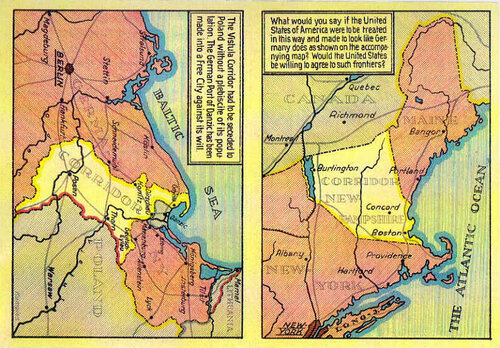
The “New England Corridor” Postcard
Since the Germans believed that the Polish Corridor was cause enough to attack Poland, they produced a number of postcards to the powerful neutral nations to show them what it would feel like to have a foreign corridor splitting their homeland. Postcards were produced for the United States, Great Britain, France and Italy. This was prior to World War II, so Germany had not yet signed a pact with Italy.
The cards open to show two maps: one part depicts a map of the Polish Corridor; the other part depicts a map showing a similar corridor dividing another country. The cards were first produced about October 1932. There is evidence that in 1939 some cards were mailed through regular postal channels, and some cards for England were air-dropped. The card for each country appears in two major varieties, one with the boxed text typeset, the other with the boxed text having the appearance of being “hand-lettered.” I first mentioned these cards in “Postcards to the enemy - Part II,” S.P.A. Journal, November 1975.
The “New England Corridor” double card for the USA shows a corridor across the Northeastern United States. The text is in English and the cards were first mailed to the United States beginning in 1932. The “English Corridor” double card shows a corridor dividing England across its narrow center. The “French Corridor” double card shows a corridor isolating southeast France. Finally, the “Italian Corridor” double card shows a corridor across northern Italy.
The above card asks the Americans:
What would you say if the United States of America were to be treated in this way and made to look like Germany does as shown on the accompanying map? Would the United States be willing to agree to such frontiers?
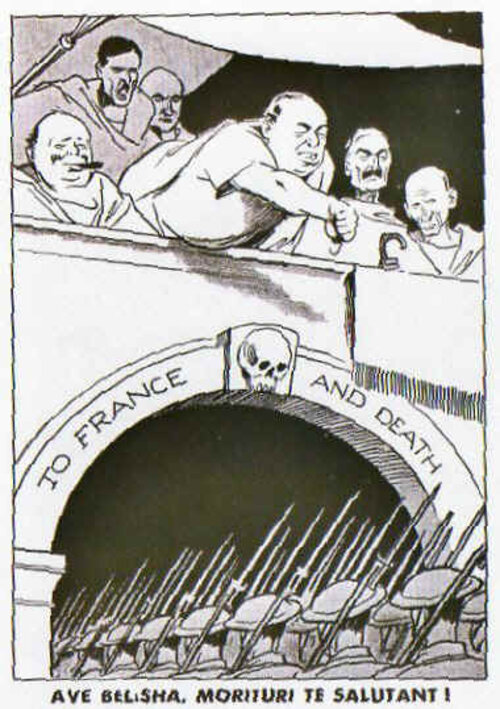
The Ave Belisha Postcard
Another interesting German propaganda postcard mailed to America in 1940 is depicted above. There were actually three postcards in this set, all anti-British in nature. Typical envelopes bear a 40-pfennig Hindenburg stamp, which was the correct postage for foreign mail up to 40 grams. The envelopes were shipped by way of the Siberia-Japan mail route to avoid British censorship. The German propaganda described the British government as corrupt and controlled by Jews who had held power for many years. These postcards were meant to convince America to stay out of a Jewish-inspired European war. This is rather ironic considering that Hitler will eventually declare war on the United States.
The cards are printed black on white stock; they show no legends or codes identifying the preparers so they are considered to be “black” propaganda. The first set of postcards was sent in a letter from Germany to “Mr. Fermone Richardson, 246 Summer, Boston Mass., USA” and cancelled 1 March 1940. Besides the postcards it contained a large leaflet entitled “Hitler and his friends” on one side. The other side shows “How Hitler spent Christmas Day” with a drawing labeled “According to the Daily Mail” showing Hitler dining alone next to a photo labeled “in Reality” showing Hitler dining happily with his soldiers in the field. Another postcard set was sent to W.J.C. Cosslebone, 99 Main, Woonsocket, R.I., USA. also dated 1 March 1940. A third set was found in Avon, New York. It is likely that hundreds of such sets were mailed to the United States.
The Ave Belisha card depicted above is a parody of the Gladiator salute with the text:
Hail, Belisha, we who are about to die salute you!
The caricatured Roman nobles in the front row are Winston Churchill at the far left, the Jewish politician Leslie Hore-Belisha, Minister for War Affairs giving the “thumbs down” sign, and Foreign Minister Anthony Eden. The British soldiers march into a dark tunnel inscribed “To France and death.”
The British later retaliated with a propaganda leaflet with similar vignette showing Hitler sending Italian troops to their doom.
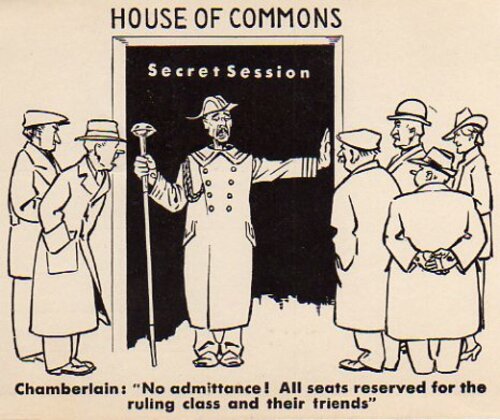
House of Commons Postcard
The second postcard that was enclosed in the envelope depicts Neville Chamberlain, dressed as a doorman; standing in the entrance of the House of Commons inscribed “Secret Session.” He holds back the public saying:
Chamberlain: “No admittance! All seats reserved for the ruling class and their friends.”
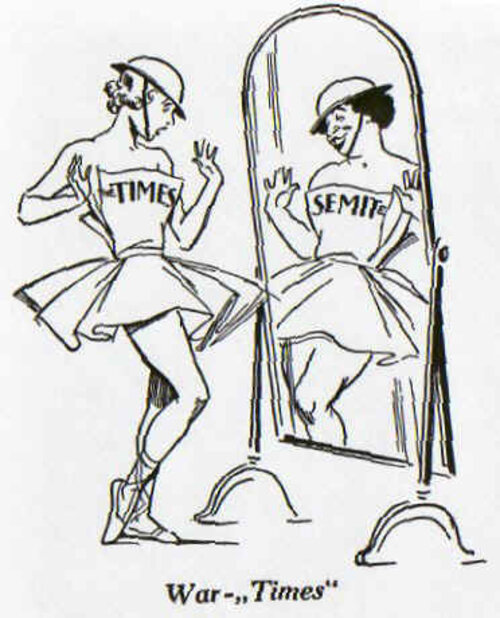
War - Times Postcard
The third postcard features a blonde British dancer wearing a British soldier's helmet, posing in front of a mirror. Her dress is inscribed “The Times.” The reflection in the mirror is a caricature Jewish female with black hair and big nose. The word “Times” on the blonde girl's dress reads “Semit” in the mirror, with an added small “e,” making the word “Semite.” The illustration is captioned “War-Times.” The message of all the postcards was to blame the ruling British aristocrats and the Jews for the war.
The Germans later produced a full-color leaflet variant of the “War - Times” postcard in the form of a cut up puzzle showing a nude blond girl holding a copy of “The TIMES” facing a mirror. The image in the mirror shows a nude girl with black hair, holding a newspaper entitled “SEMIT eht.” The pieces of the leaflet were contained in an envelope entitled “Puzzle” and dropped on French soldiers in the Maginot Line.
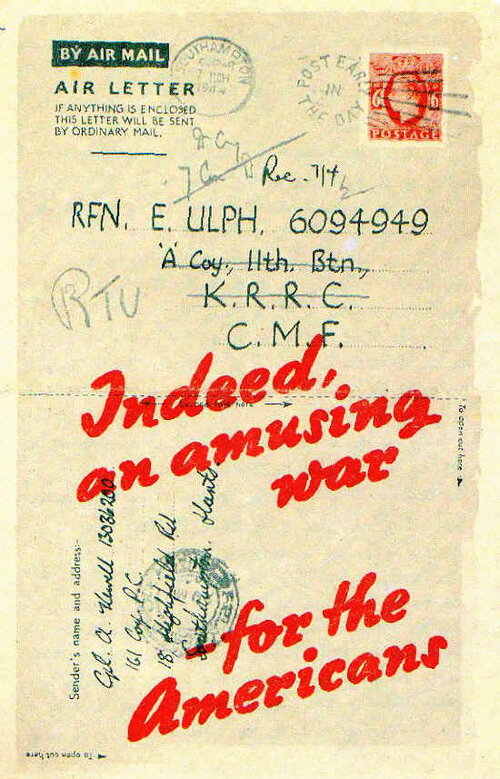
“Indeed an Amusing War” Letter Sheet
This single-fold German parody of a British air letter sheet is imprinted with a 6 pence King George VI stamp, opening to show a large red broadside in English covering the outer front and back. The uncoded leaflet was prepared by the German propaganda organization “Southern Star” in an attempt to divide the American and British troops in Italy in 1944 and 1945. It is dated on the inside “6-3-44.” Some of the text on the front of the leaflet air letter is:
Indeed, an amusing war - for the Americans
[to] RFN. E. Ulph, 6094949
“A” Coy, 11th. Btn.
K.R.R.C. C.M.F.
[from] Cpl. A. Newell, 1306280
161 Coy. P.C.
18 Highfield Rd.
Southhampton, Hants
When turned over. the inside contains a fake letter from a disgruntled British soldier to an army friend. Some of the text is:
Well pal, how much longer do you reckon this bloody war is going to last? I know that I’ve experienced nothing compared to you, but I am utterly fed up with the army. I wish it were all over and we were back together again. Let’s hope that wonderful day isn’t so far away…
We get a few air raids here so it keeps us reminded of home. My pal and I have been to one or two dances in town but you can’t get a look in for Yanks. The place is lousy with them and the girls won’t dance with the Tommies while the yanks are around.
When American troops landed in Britain in force they sometimes teased the locals about being “underpaid, undersexed and under Eisenhower.” The British often replied about the Americans: “oversexed, overpaid and over here.” This German leaflet uses that undertone as divisive propaganda. The title, “Indeed and amusing war…” was used in a number of other German leaflets, usually sexual in nature.
Readers who have further information on the subject, or information on OSS activities as they related to postal matters, are encouraged to write the author at Sgmbert@hotmail.com.